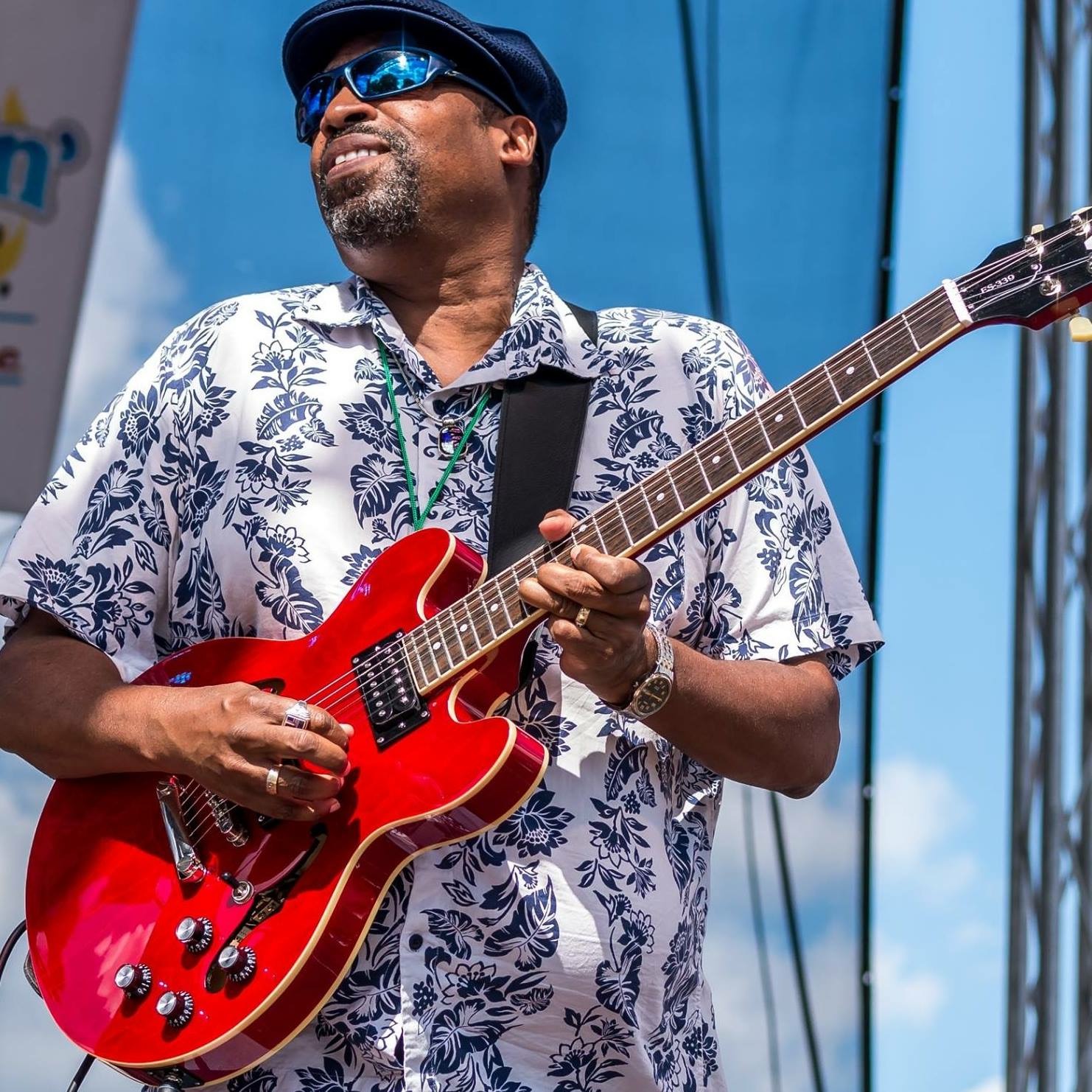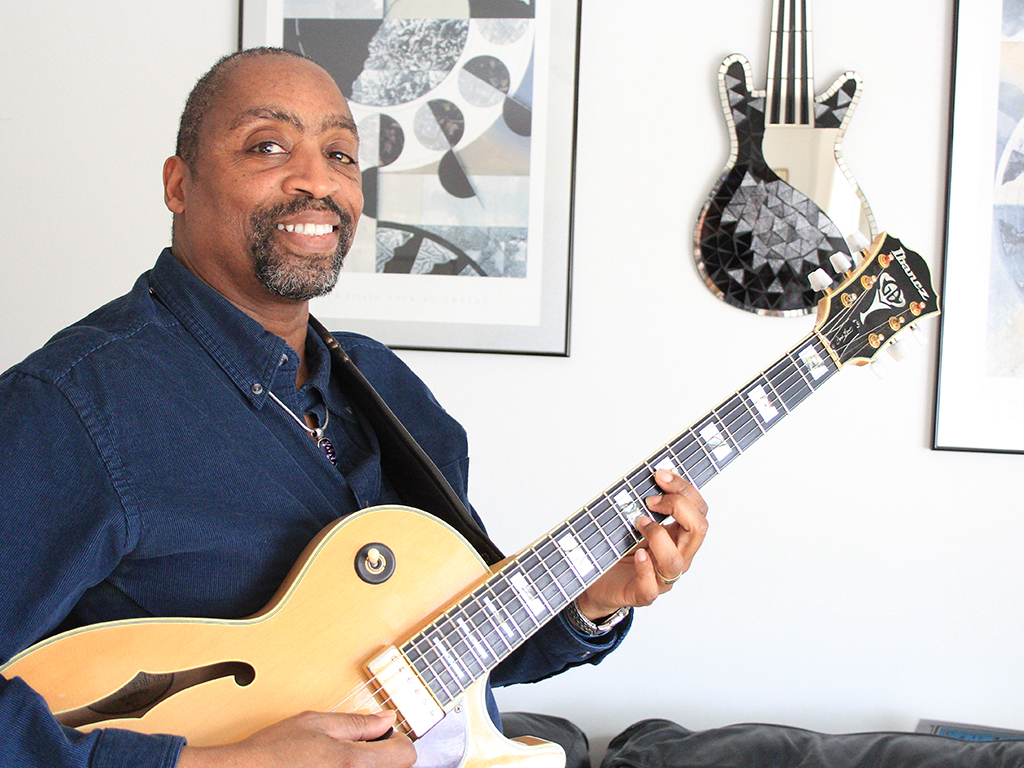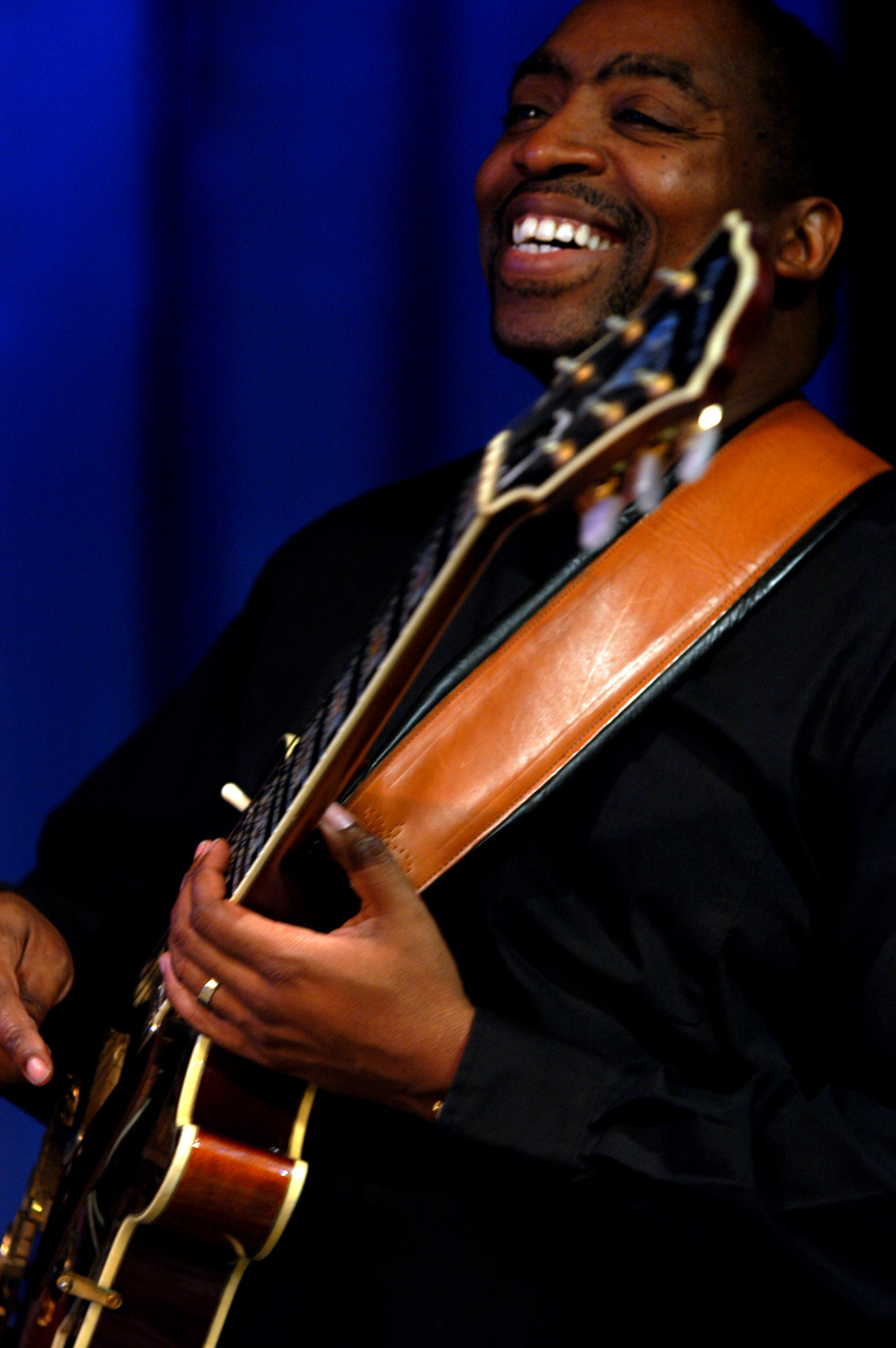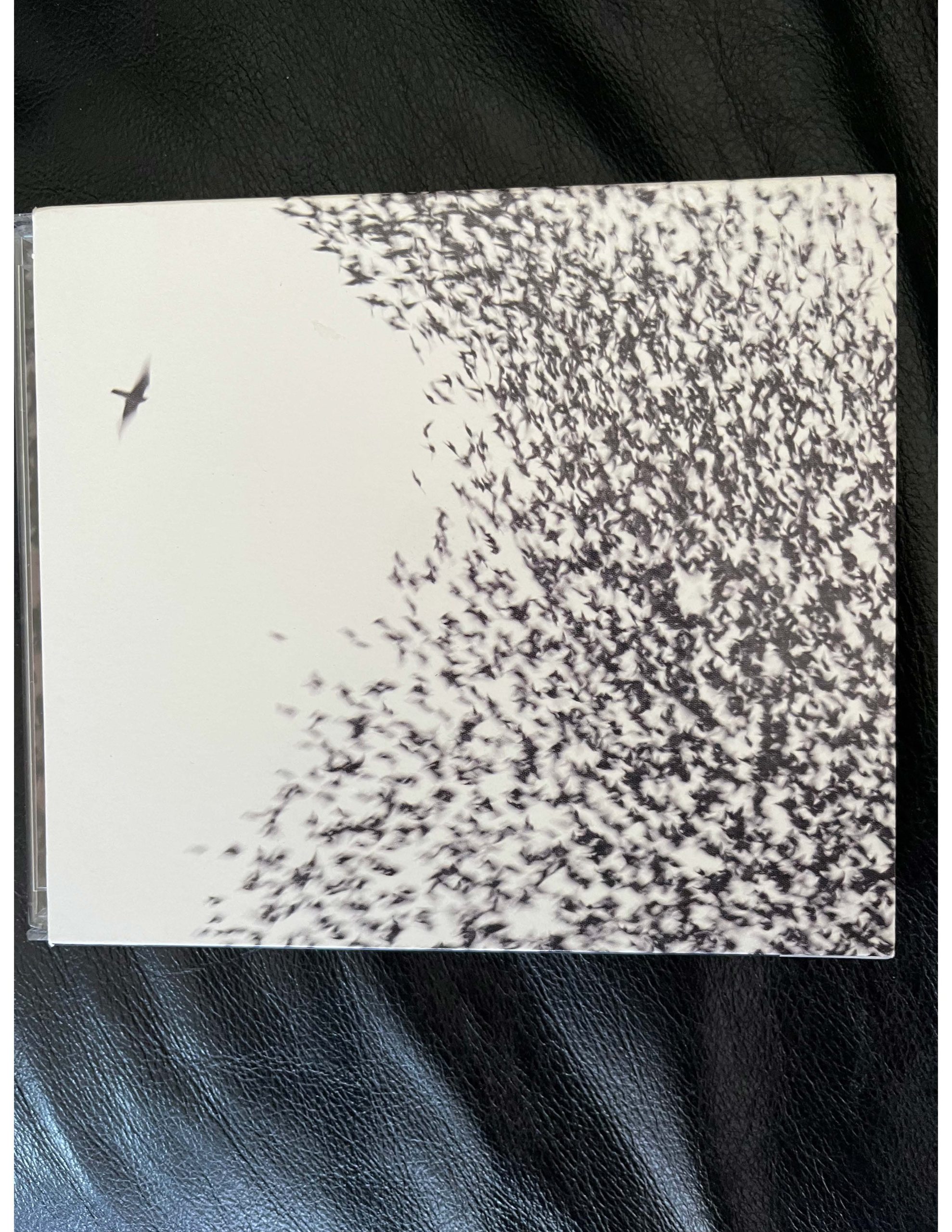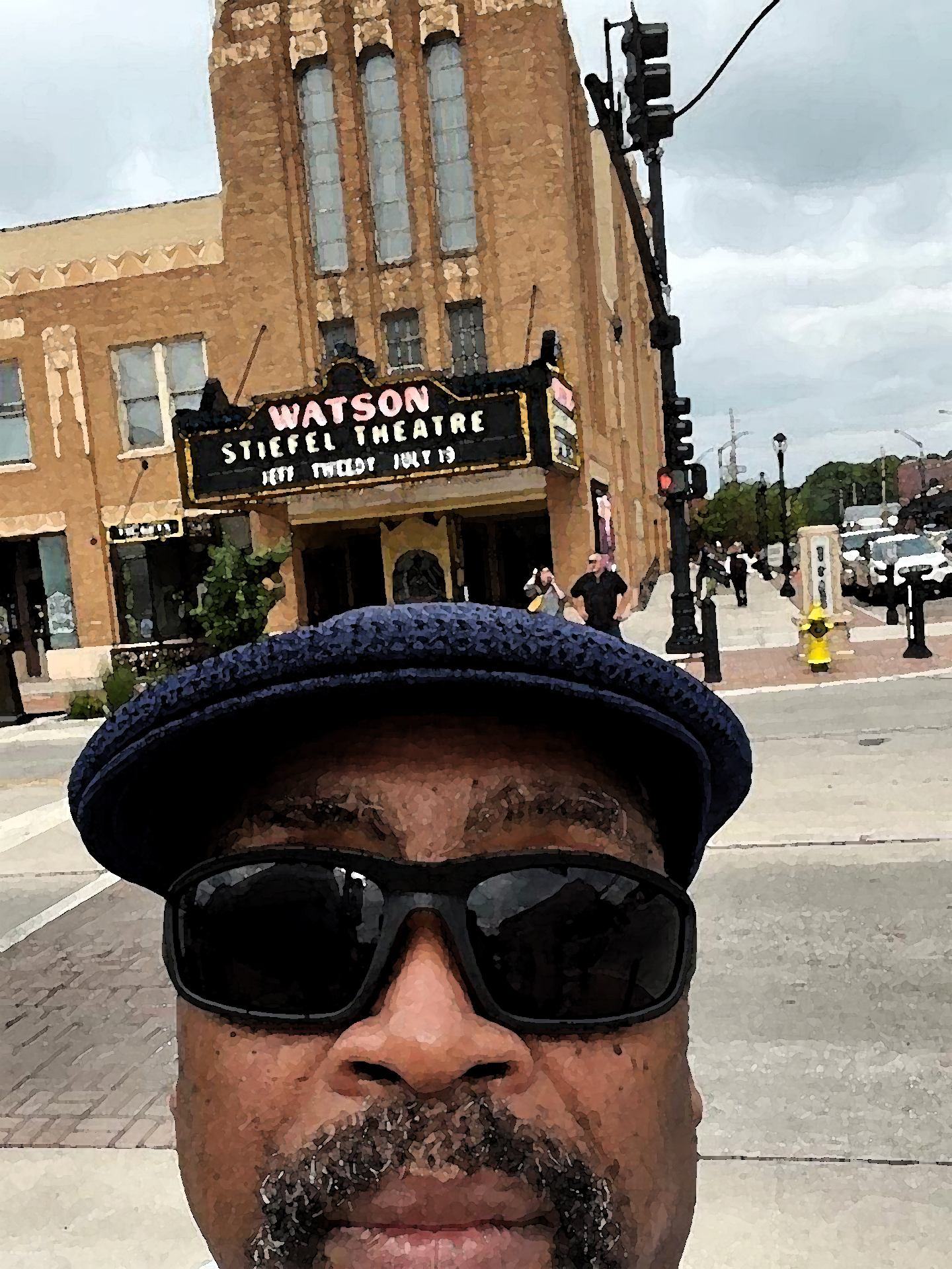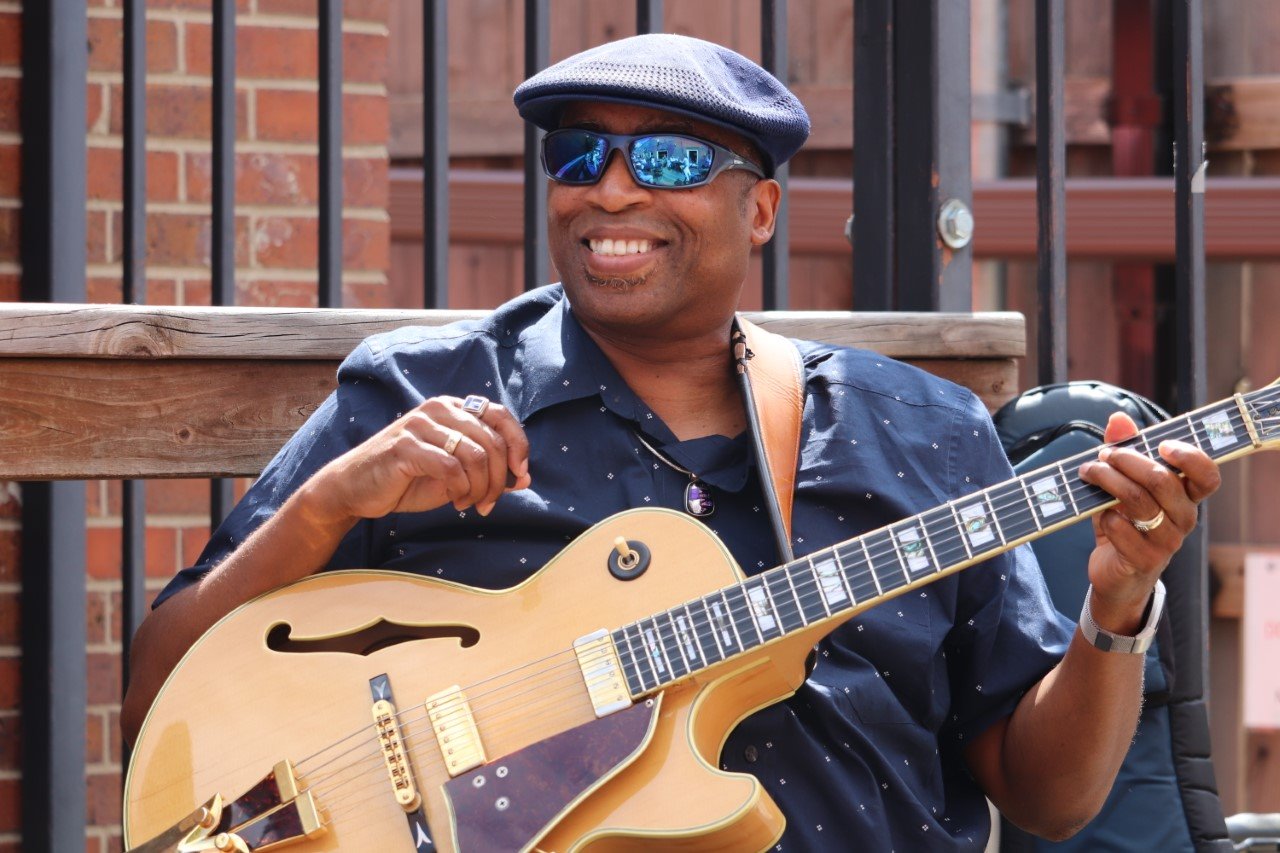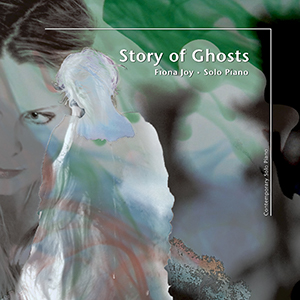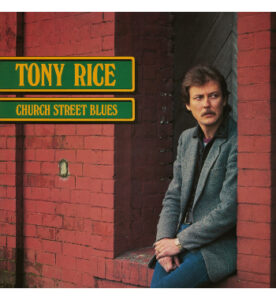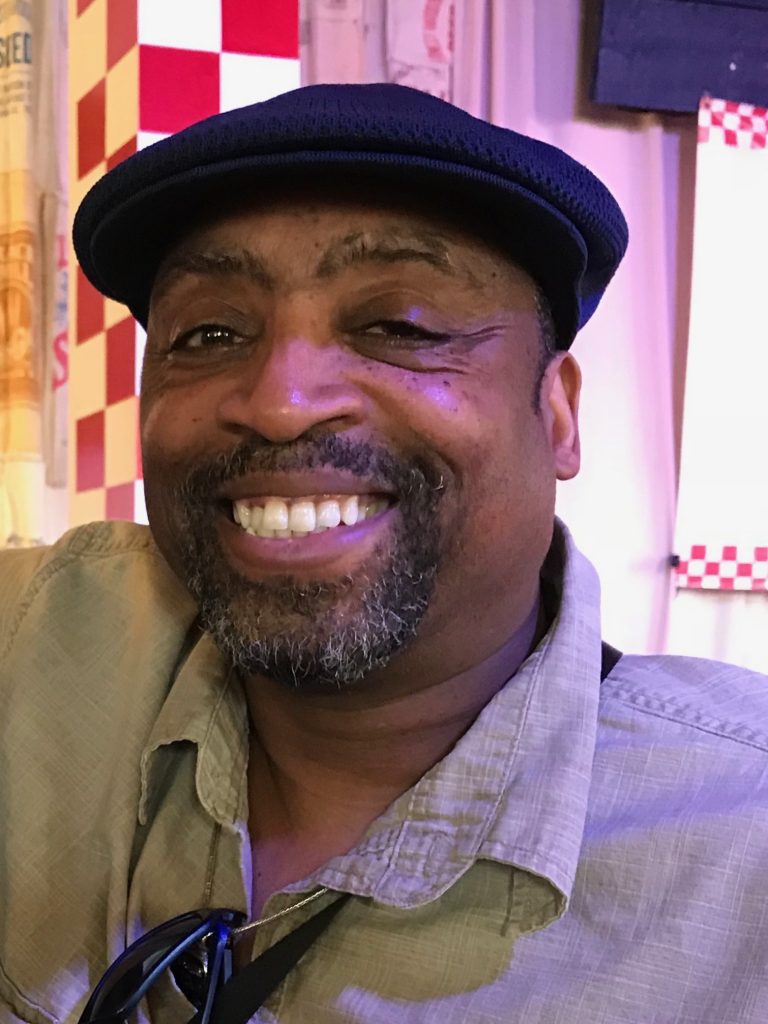
Part 1: The Awaking
Late October of last year, a friend of mine who lives in Wichita Kansas, came to visit me for a jam session and a guitar lesson. We had a great time, and when he made it back home, he sent me a text photo of a vinyl haul he'd snagged at a garage sale. After rattling off names of the many used records he got for a steal, he showed me the picture of this one:
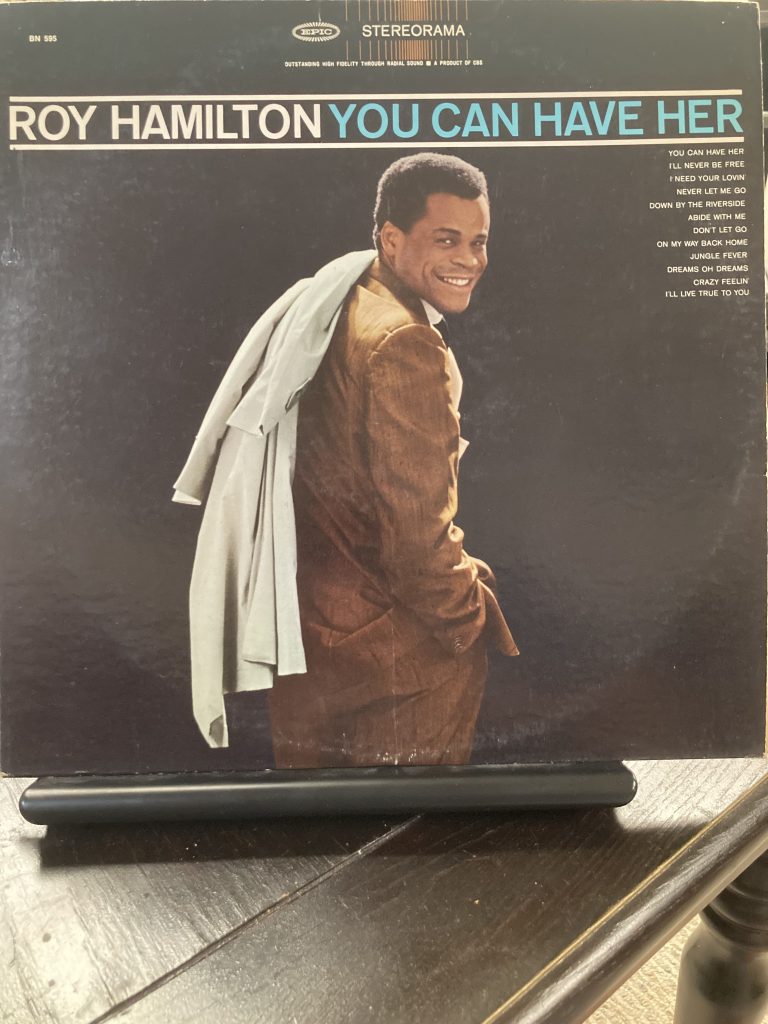
When I saw it, something happened that really shook me. Who was this guy? Roy Hamilton? Never heard of him! But others had. Hamilton had scored a big hit with this song when it hit the airwaves in 1958, reaching #2 on the urban charts and #13 on the pop charts. But this had happened before I was born, and it's 1972—that song isn't being played on the radio now. He's not at all a household name…Roy Hamilton??
I hadn't seen the album cover in fifty years. My brother-in-law, Joe Nathan Thomas—who lived upstairs from us in our house located on the South Westside of Chicago—had that album cover. I'd only seen it briefly, sitting on the floor with dozens of other classic rock LPs he played literally every day. Joe was the first audiophile I had ever known, and he had everything anyone would dream of when it came to rock music. As a kid, I was never allowed upstairs, and only heard the albums he played on his hi-fi stereo being transported through his floor-model speakers, the sound booming through the cones and being magnified through the wood and linoleum overhead. I hadn't thought about those days in a long, long time. But I do remember hearing music in a way that none of my other brothers or sister seemed to have even noticed or acknowledged.
One look at that handsome face of Roy Hamilton on the cover, and suddenly I had a major flashback—and I remembered it like it was yesterday. All the sounds, feels, smells, and colors came flooding in. I was suddenly teleported back in time to 1972, laying on the bunk bed in the cove off the living room, arms folded underneath my head on a pillow, staring up at the ceiling where I could, almost seeing it bounce as I could hear the bass line pulsating through the floor above me, soundwaves traveling magnified through the planks. Somehow, I remember not being allowed to come upstairs too often, seeing as how my older sister Varnetta was living with her husband and that was their home before they actually bought their first house and moved away. Those were some of the most influential years of my life, and I'm sure Joe didn't realize the significant impact he was having on me at the time. But for me, it was a major moment in time, actually not just a moment, but an entire period—which lasted for the entire time they lived upstairs.
Hear that whistle, it's six o'clock
(Don't let go, don't let go)
Come on baby, it's time to rock
(Don't let go, don't let go)
I'm so happy to have you here
(Don't let go, don't let go)
Keeps me grinnin' from ear to ear
(Don't let go, don't let go)
Chorus
Ooh wee
This feeling's killing me
Oh shucks
I wouldn't stop for a million bucks
I love you so
Just hold me tight and don't let go
(Don't let go, don't let go)
I heard the music before I ever connected a specific face to this song I fell in love with. When Jack Chase sent me that text photo of the album cover, I knew it was what I'd been looking for all these years. Here's what struck me though: That hard-swinging song—the one that always made me think of Elvis Presley for some reason—wasn't actually Elvis, but he was somehow channeling that style, and, strangely enough, this dude was black! Yet his voice, his look, his style—seemed to register even more naturally to my sensibilities than Elvis did.
At the time, I remember thinking, this guy sounds like Elvis Presley—he sings with that same sassy attitude. Little did I know that there was, in fact, an actual connection between these two men, and it wasn't just my imagination. What I heard was real. As it turns out, the man who wrote those lyrics that inspired that confident, swinging, swaggerish (is that a word?) style was none other than Jesse Stone, an unsung hero in the annals of American music, and, more specifically, the obscured music history of black America. Stone had made his mark numerous times on the industry with such R&B hits as "Shake, Rattle and Roll" and "Flip, Flop and Fly." He'd already worked with and written and arranged songs for Duke Ellington, Louis Jordan, Ray Charles, and a host of others. His music was not foreign to Elvis who had performed both tunes during the broadcast of the Dorsey Brothers Stage Show on January 28, 1956.
But I still didn't know: Why did Elvis and Roy sound so much alike? As it turns out, Jesse Stone had a regular working relationship with another African American whose name would be equally as relevant in this story. He was Otis Blackwell, one of the greatest—and yes, also unsung—heroes of the music history. In an amazing twist, Blackwell served as the connective tissue between the world of Elvis Presley and the lyrics of Jesse Stone. He was a highly-skilled producer who was always sought after whenever Presley need a "hit-maker" to put him at the top of the charts. He worked extensively in New York, Memphis, and Nashville. So, what about some of my favorite songs I loved from all the Presley movies I watched as a kid? "Return to Sender?" "Don't Be Cruel?" "All Shook Up?" Oh, yes—every one of those tunes had this same hard swing to them, and Elvis sang them like he was tapping into to something…urban. Those songs jumped right out at me and struck my very soul. So, it really was more than a coincidence: Blackwell produced all those tunes too. He even wrote "Great Balls of Fire," (under the pseudonym of John Davenport) made famous by Jerry Lee Lewis! But Blackwell and Presley had literally never met each other, and it remained that way up through the end of their lives. But I digress…
Part 2: The Hunt
This singular, specific tune, "Don't Let Go," was actually the B-side of the tune, "The Right To Love," released on Epic Records. I had to know more, so I went on a hunt to find everything I could about the connection between Hamilton, Elvis, Stone, and Blackwell. I started by first getting copy of the album that had held me in mystery for five decades.
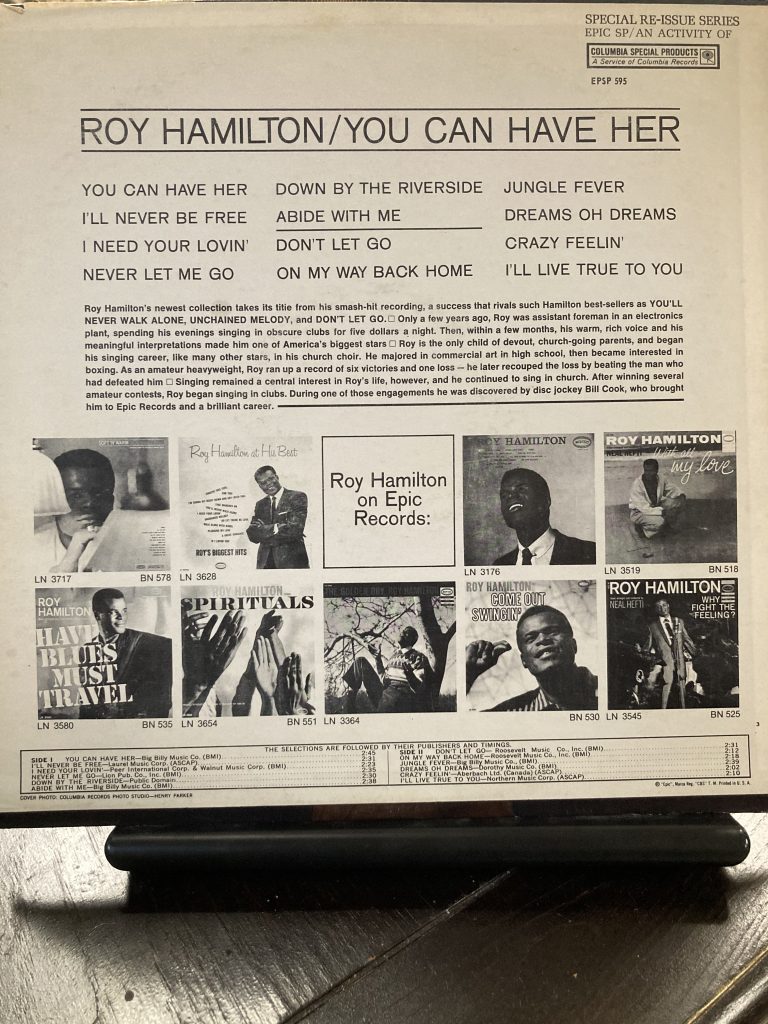
This album, You Can Have Her (Epic BN 595), was released in 1961, a couple of years after the original singles were released. I discovered that the album was still well-known and respected today as one of the most popular albums Hamilton has ever recorded, so I found a VG+ vinyl copy—a newly-reissued version (EPSP 595) on Discogs for only $8.50 (including shipping):
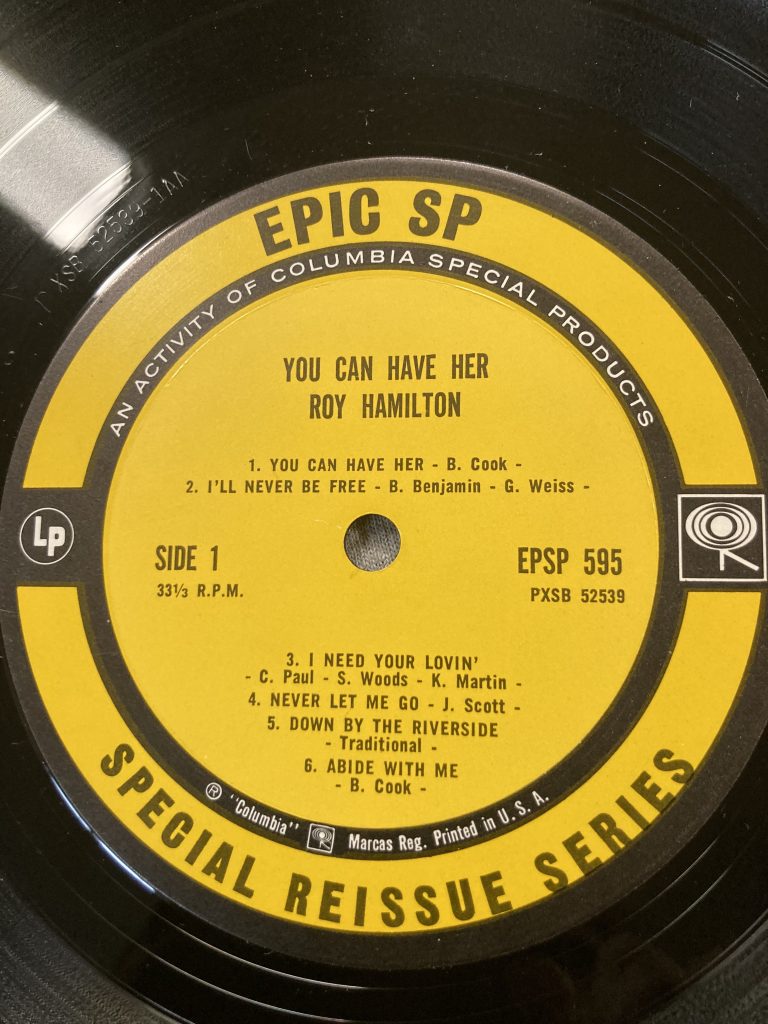
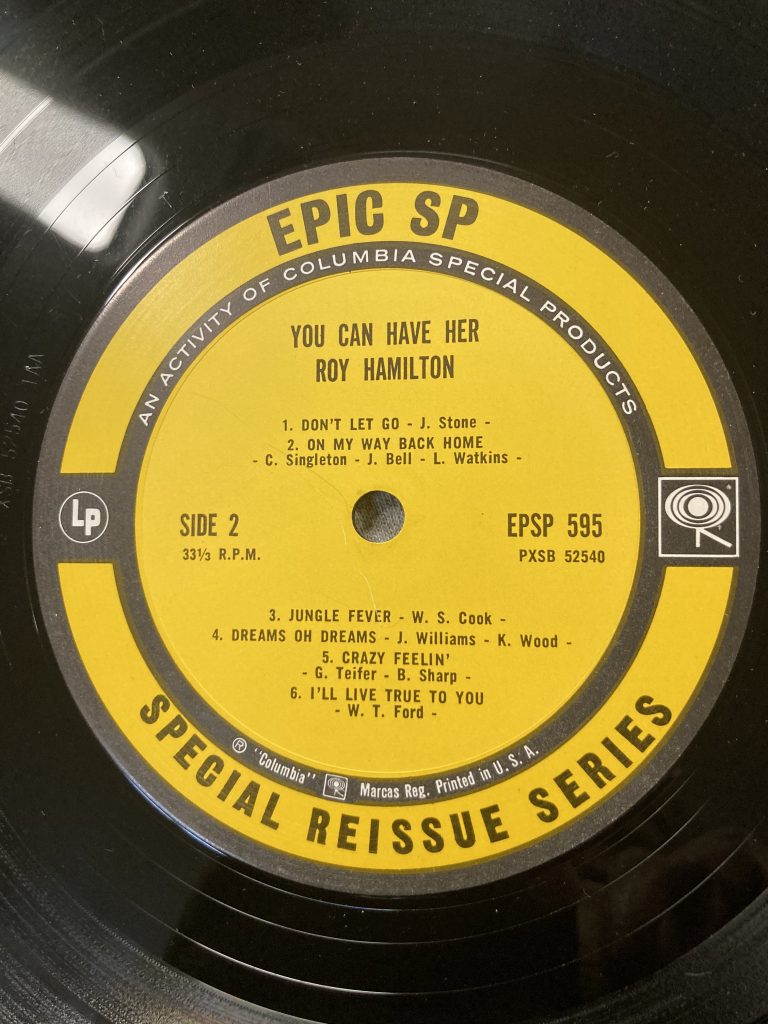
Being the thorough researcher that I am, I then went on a search for the original 45 (Epic 5-9257) that started the whole thing back in 1958. I found a great copy on Discogs for $2.29, and it was sent to me inserted in the original Epic records sleeve.
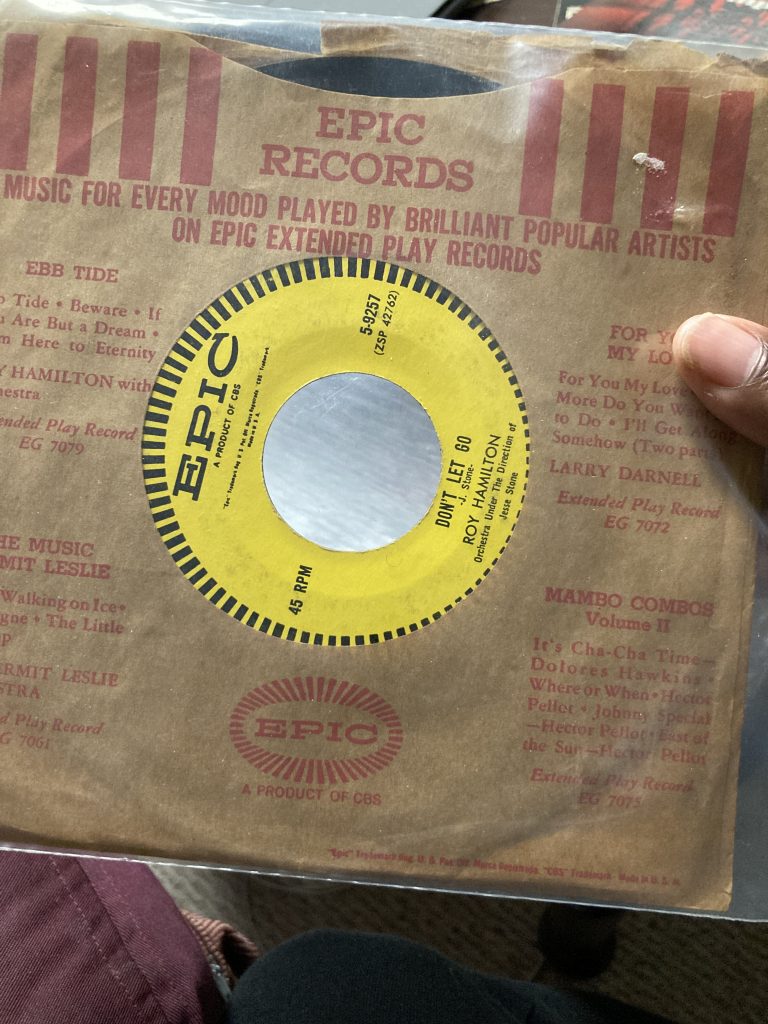
I was surprised to discover that the A side was in fact, the song called "The Right To Love"…
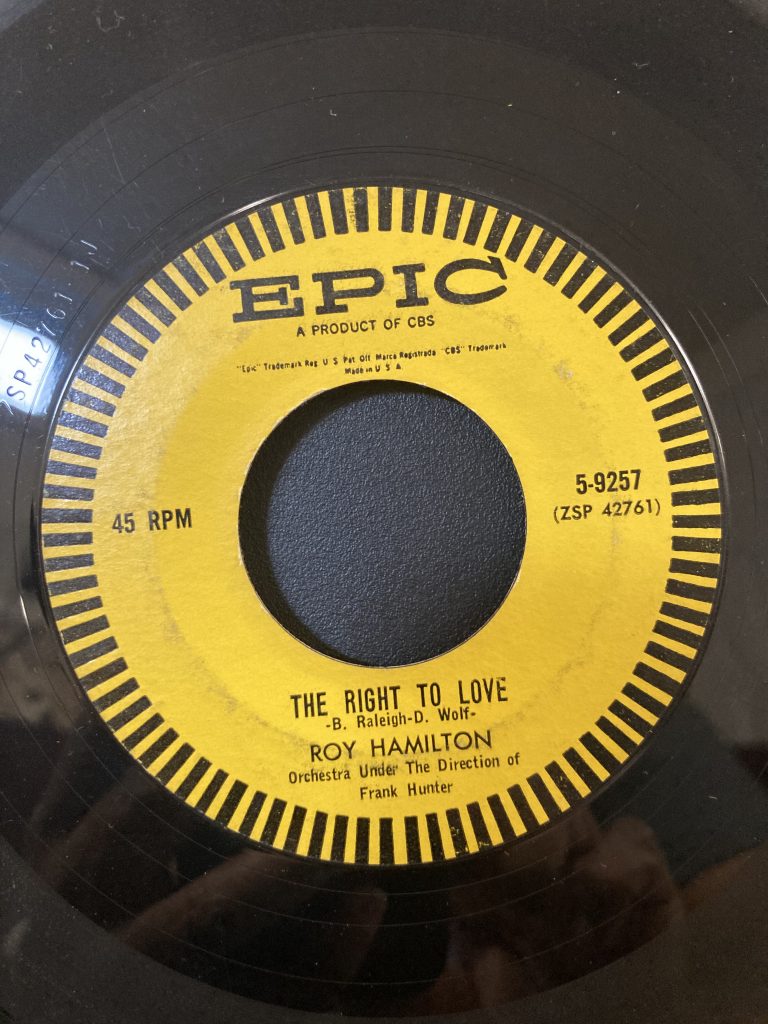
…the stamp code of 7SP42761-1J on it. The "B" side (7SP42761-1J) was the song that became the actual hit!
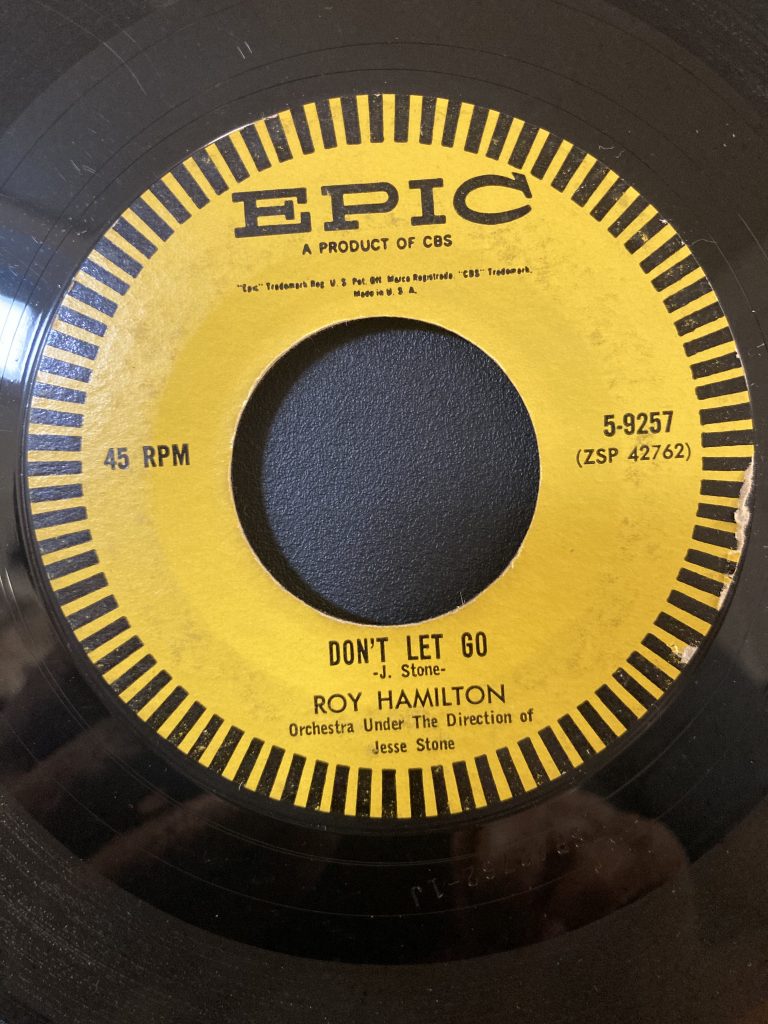
The recording sounded fantastic when I gave it a spin on my mono rig.
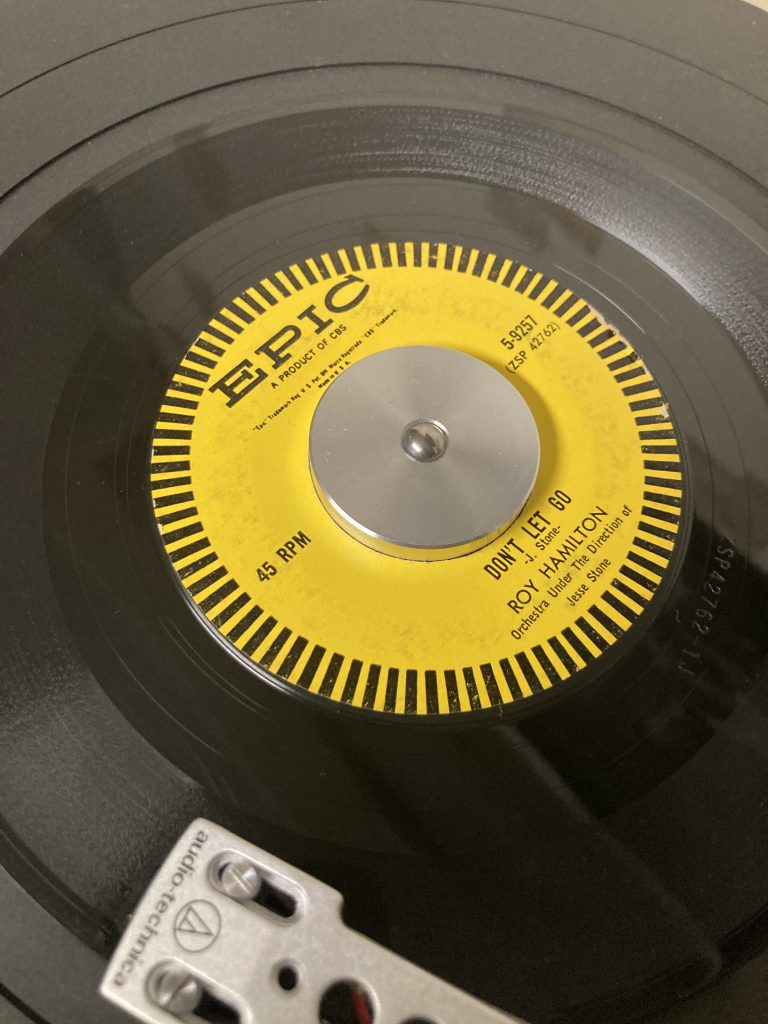
Hear that whistle, it's six o'clock
(Don't let go, don't let go)
Come on baby, it's time to rock
(Don't let go, don't let go)
I'm so happy to have you here
(Don't let go, don't let go)
Keeps me grinnin' from ear to ear
(Don't let go, don't let go)
The sound immediately takes me back: the boogie-tight guitar melody playing in sync with the bass; the presence of his chocolate-covered vocal delivery; heavy reverb on background vocals, with four-part harmony singing the root, 3rd, 5th, and octave notes during the refrain. The snare popping on beats two- and four- as the dry brush technique on the drum skin with no kick drums or cymbals or high hat played throughout the entire tune. No piano on tune anywhere!
After four verses interspersed with choruses, Hamilton's unbridled hand claps are heard a couple of times on the "out chorus" vamp—the band is swingin' so hard, he just can't hold back any longer!
Just hold me tight! (Don't let go,)
Just hold me tight!! (don't let go!)
Ho-old me tight!! (don't let go!)
Part3: The Holy Grail
I listened to the entire album and was amazed at how I could have gone this long without having Hamilton in my life. I wondered, where did he come from? How did he get such a powerful style? I dug deeper, and discovered that even before the You Can Have Her album, Hamilton had carved out a unique place for himself when he recorded on Epic Records a classic version of the popular tune, "You'll Never Walk Alone," the show-stopping tune from the 1945 Rogers & Hammerstein Broadway musical, Carousel.
I started the hunt—I hopped on Discogs again and chased him down. I learned that there was a 10" album that was released in 1954 featuring Hamilton's version of the tune (Epic LG 1023) This interesting disc—which falls somewhere between a 78 and a 33 RPM LP—has four songs on each side. The copy I found came in "VG+" condition, and only cost me $9.45, with $5 more for shipping—a great find.
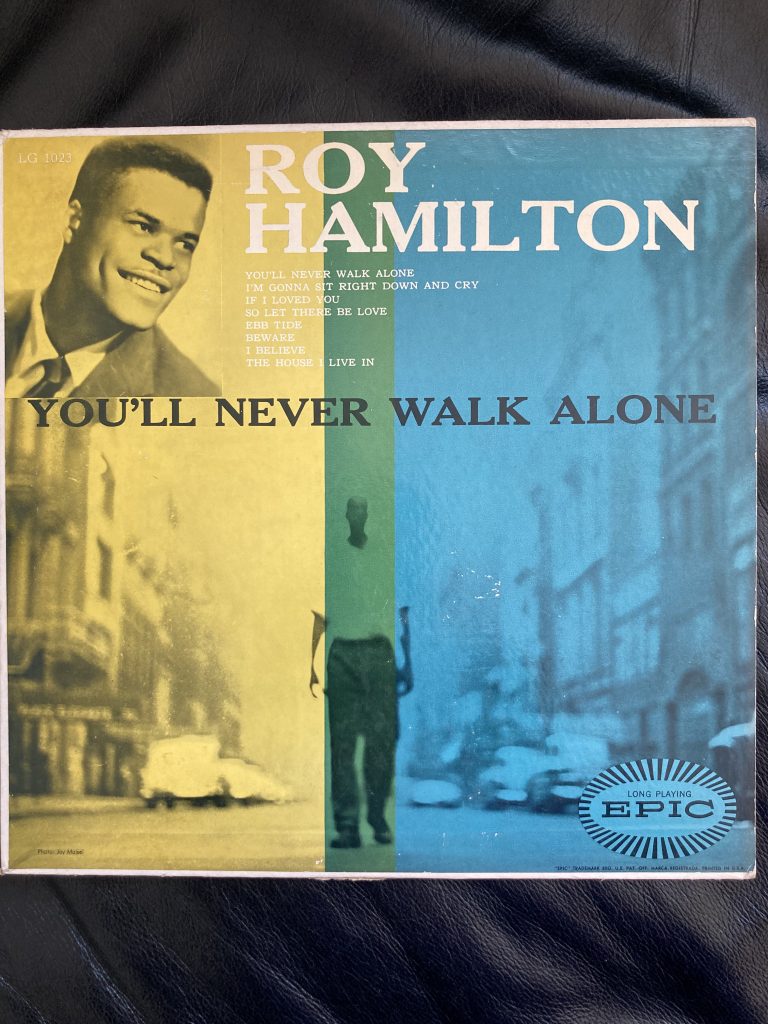
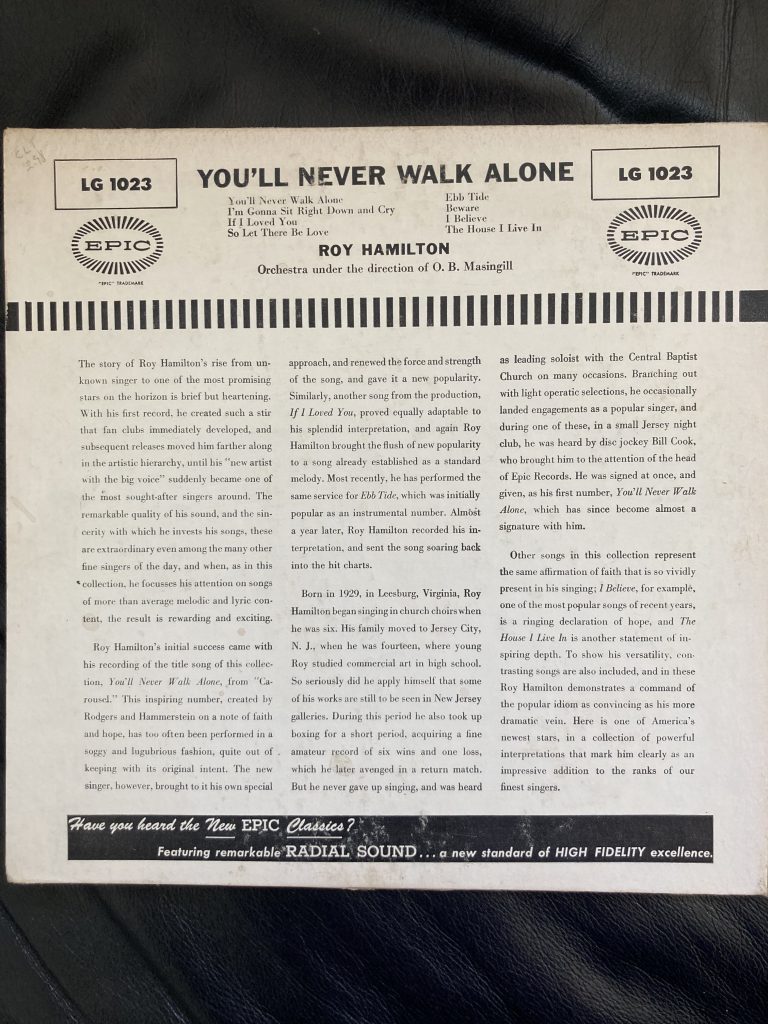
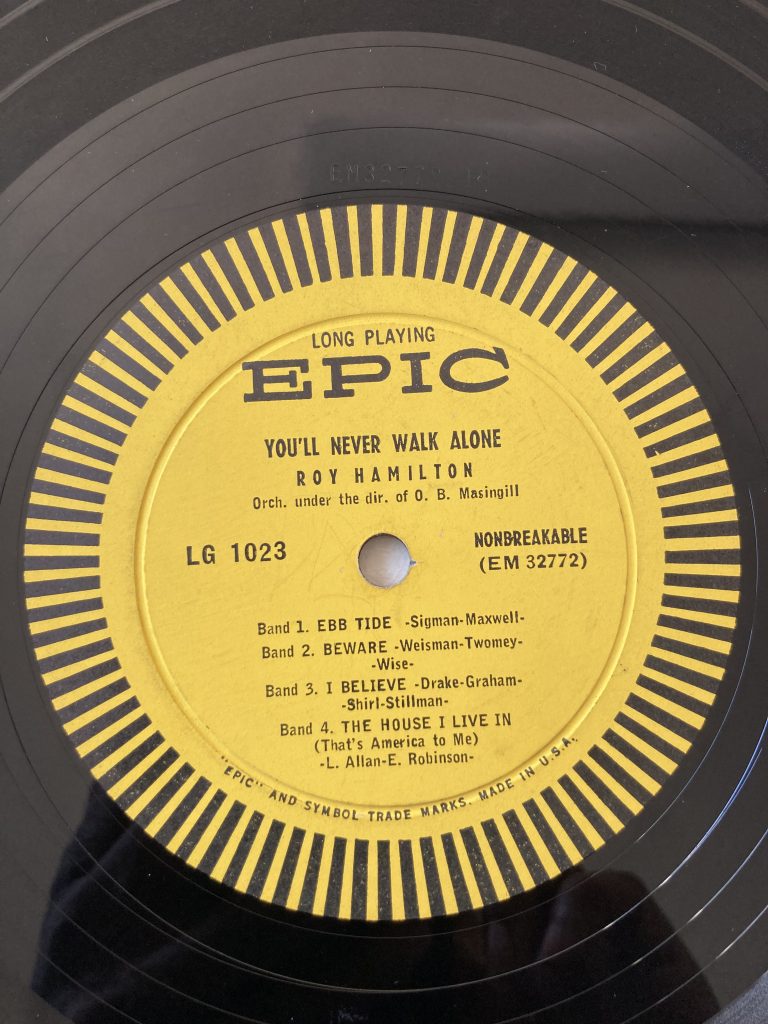
The package arrived with the platter looking in great condition; the album cover in immaculate shape with no bends or creases in the card stock; a fresh new cardboard white sleeve for the disc; and all three were inside a sturdy plastic slip cover. I popped it on my mono rig with the Technics turntable, and the aural ecstasy was evident.
But wait, there's more! Something caught my eye as I was blissfully listening to the glistening sounds—there's a bit of writing inside the cardboard sleeve of the album cover. Wait a minute…could it be? Wow!
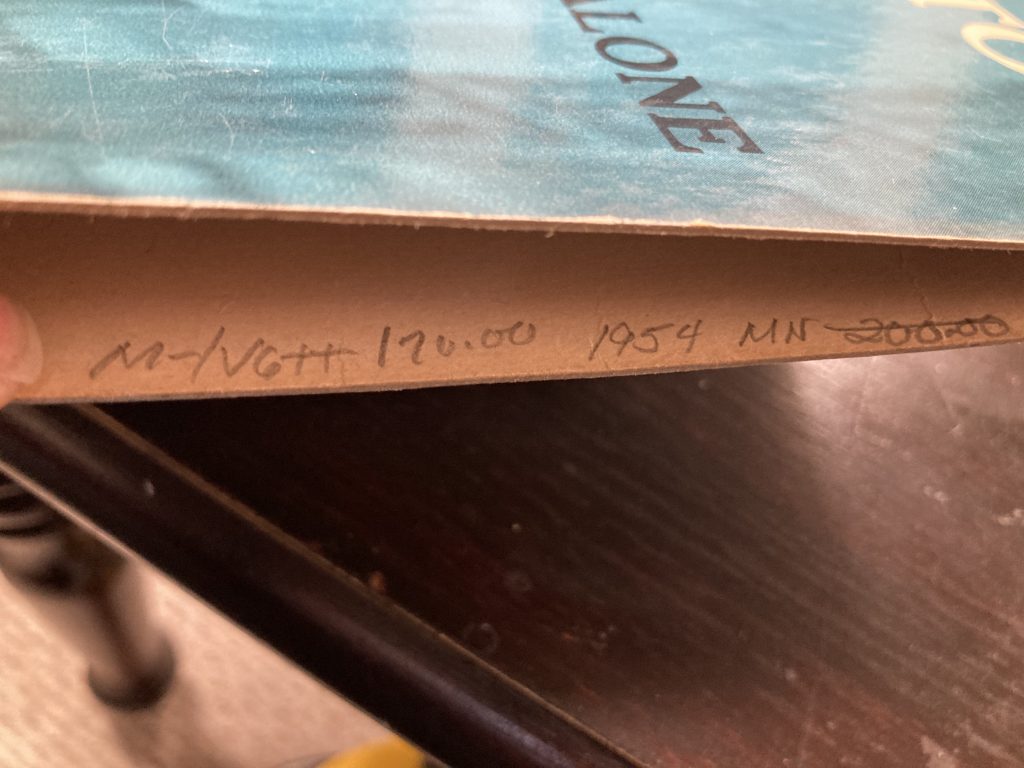
Am I looking at inscribed notes from a previous seller that documented the asking price from some time ago? Categorized as somewhere between "Mint" to "Very Good Plus/Plus" condition for $170? And it was marked down from $200.00? Yes, my $14.45 was absolutely worth it!
After further research, I discovered that the vintage album I had served as the precursor to a full-length album. Released in 1955, the mono 12" album, You'll Never Walk Alone (Epic LN 3294) has six songs on both sides, and features the tune as the first track on Side A. In a surprising move, I picked up an excellent copy from—of all places—Amazon, for only $3.99, and another $3.99 for shipping cost for a grand total of $7.98. The album came in wonderful condition, and when I gave it a spin, it sounded fantastic, with minimal popping or hissing, no scratches, and smooth grooves—physically and sonically speaking!
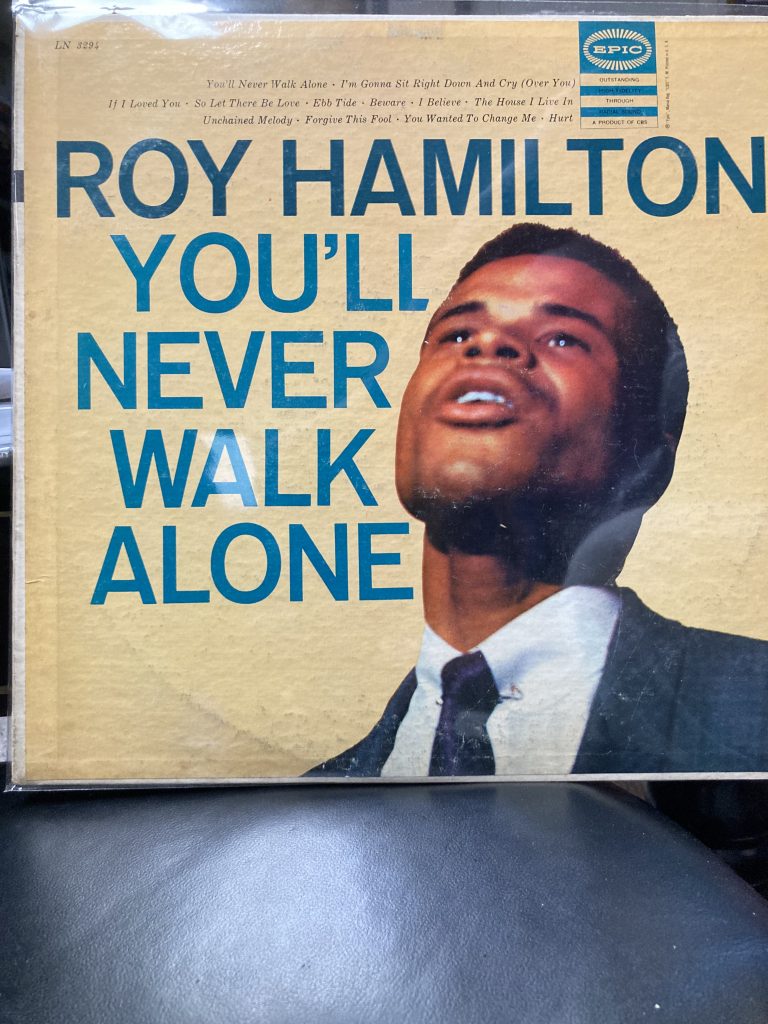
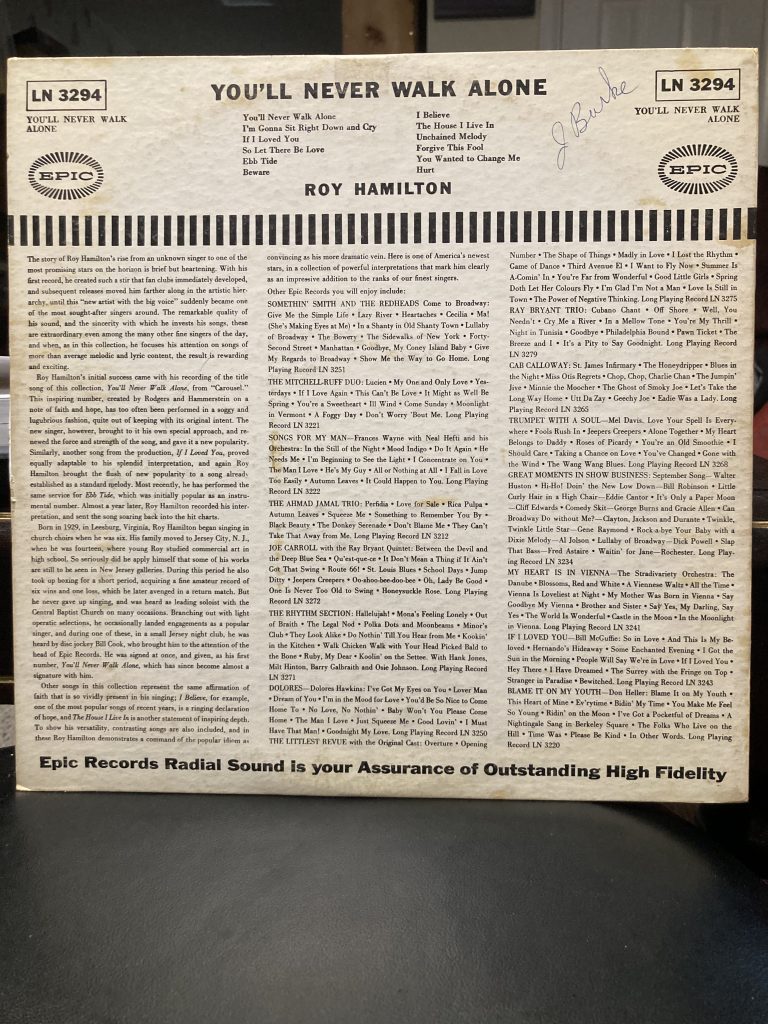
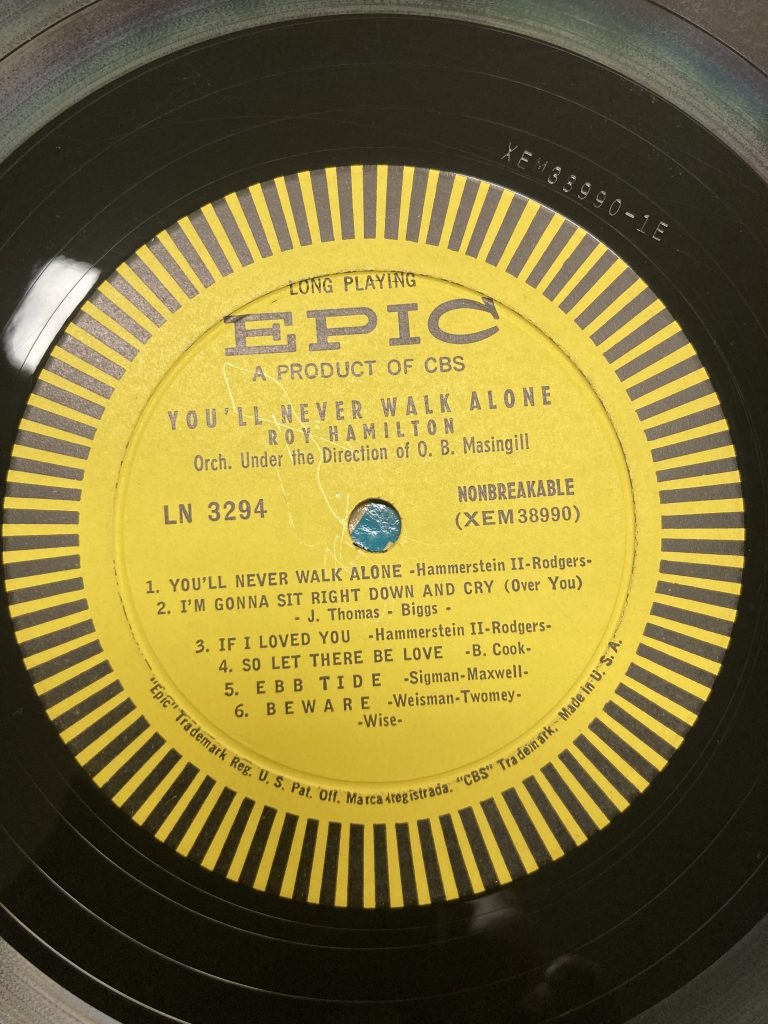
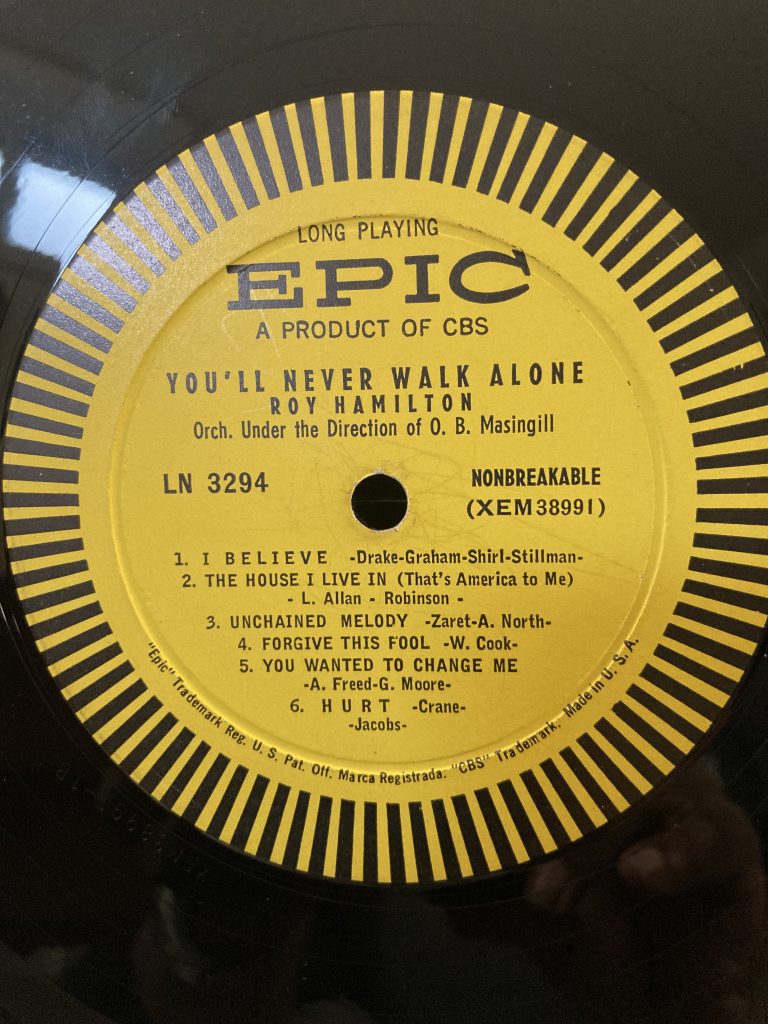
The more I listened to Hamilton's golden voice, the more it seemed to me that I could hear Elvis Presley's style coming through the speakers—after all, it was his voice that I knew and grew up listening to, loving his song, his movies, too! But I can't seem to shake this feeling, this nagging question of wondering: Who—or what—came first? Could it be that Elvis himself discovered Hamilton years before he became "The King" and was also spellbound by Roy's voice like I was? I needed to know. One thing's for certain: Part of the answer can be found in the common denominator—Otis Blackwell. So I started snooping around—first in Hamilton's backyard to find out how he developed that signature sound in the first place. Then I did some digging on Elvis, to find out how he somehow sounded so much like my new hero, Hamilton. What I discovered totally shocked me.
Part 4: The Roads Converge
A quick Wikipedia search on our man Roy revealed that he was a major influence on none other than the great soul singer, Jackie Wilson, who was a superstar at the Apollo Theater, the mecca for black entertainment in the late 50's. In fact, he was what you very much might call our "Black Elvis." Wilson had all the swagger, the dance moves, the handsome face, the impeccable dress, the patent leather shoes, the greased pompadour, and the lady-killer crooning voice as early as 1950. That husky, heavy vibrato and the wide, powerful vocal range that soared above the crowd? He had it. The snappy fingers, the jingling, twisting hips, the drop-to-your-knees-with-the mic move? He had it. He was known as "Mr. Excitement!"
I found out that Elvis was definitely aware of Jackie Wilson, and had seen him in person for the first time in 1956, when Wilson performed in Las Vegas with Billy Ward & The Dominoes, who recruited Wilson to join his singing group in 1953. Jackie stayed for three years, started his solo career in 1957, and became a solo star.
Jackie's reputation and unique singing and performance style were being developed before the great Elvis songs like "Don't Be Cruel" and "All Shook Up" were released. But here's the kicker It also happened before Hamilton's 1958 recording of "Don't Let Go." So, it looks like there's a bit of the chicken-or-the-egg dilemma here—which came first? Upon closer examination, we discover that of all three men, it's Roy Hamilton who's oldest, and whose recording and performing career came first. In fact, he arrived at the Apollo and tried his hand (with little success) years before Jackie wowed the crowd. Roy won a contest at the Apollo as early as 1947, but he couldn't fully capitalize on it because the Harlemites ultimately wanted someone who was more of a blues singer, which Roy wasn't—he was more gospel at the time. But Jackie certainly was. Also, Hamilton's highly successful "You'll Never Walk Alone" was released in 1954, before Elvis or Jackie's career took off.
So now the plot thickens—we now discover that Jackie—who surely influenced Elvis – has copied Hamilton! Indeed, in Fred Worth's 1984 biography on Presley, he acknowledges, "Elvis greatly admired Hamilton's singing ability and style and performed a number of his ballads in Hamilton's style." Meanwhile, Jackie had undoubtedly heard Roy's version of 'Walk Alone'—either in either 10" or 12" version. So, what does he do? In a show of "one-upmanship," he records his own version for his latest album, Spotlight On Jackie Wilson (Brunswick BL54119).
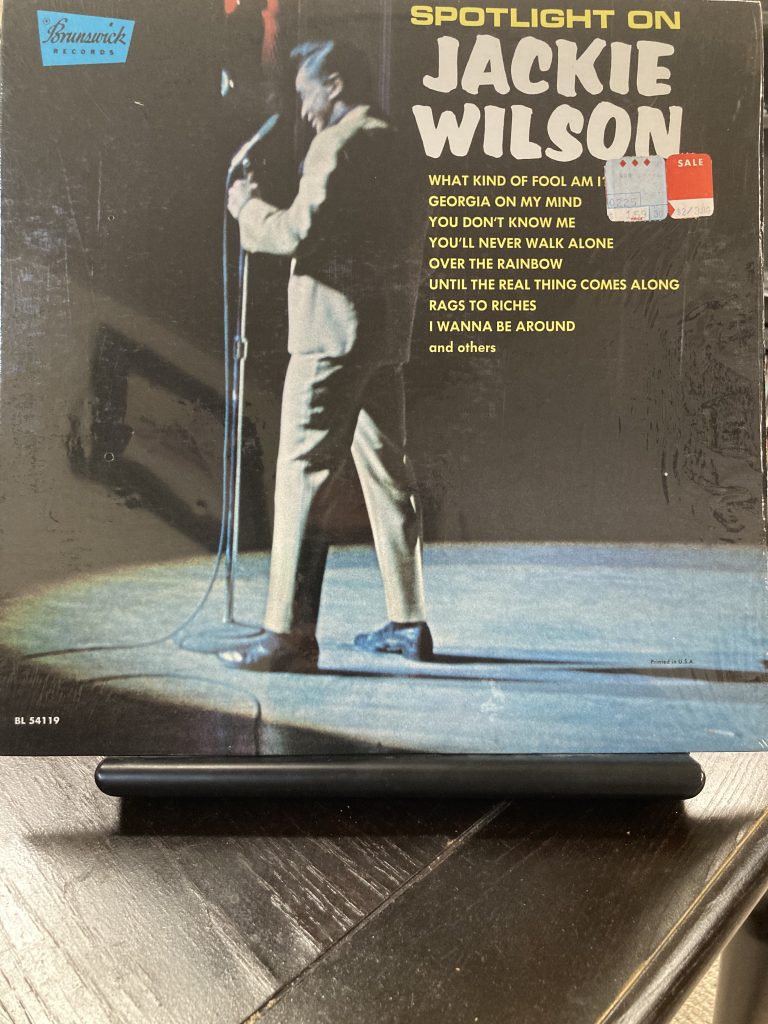
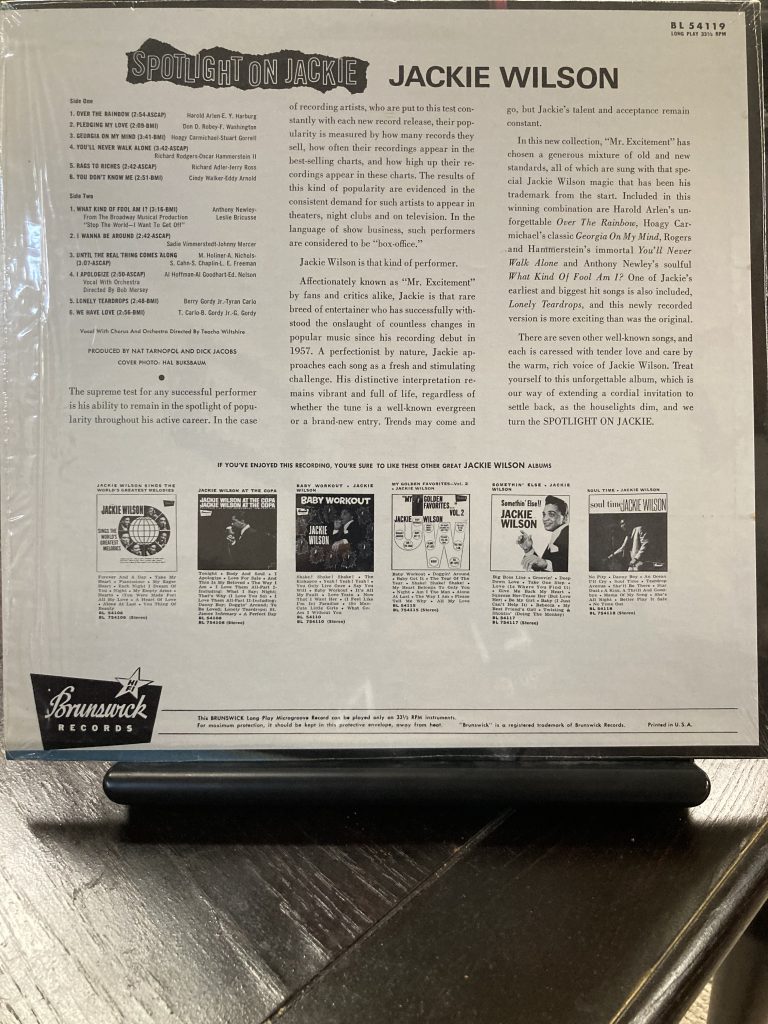
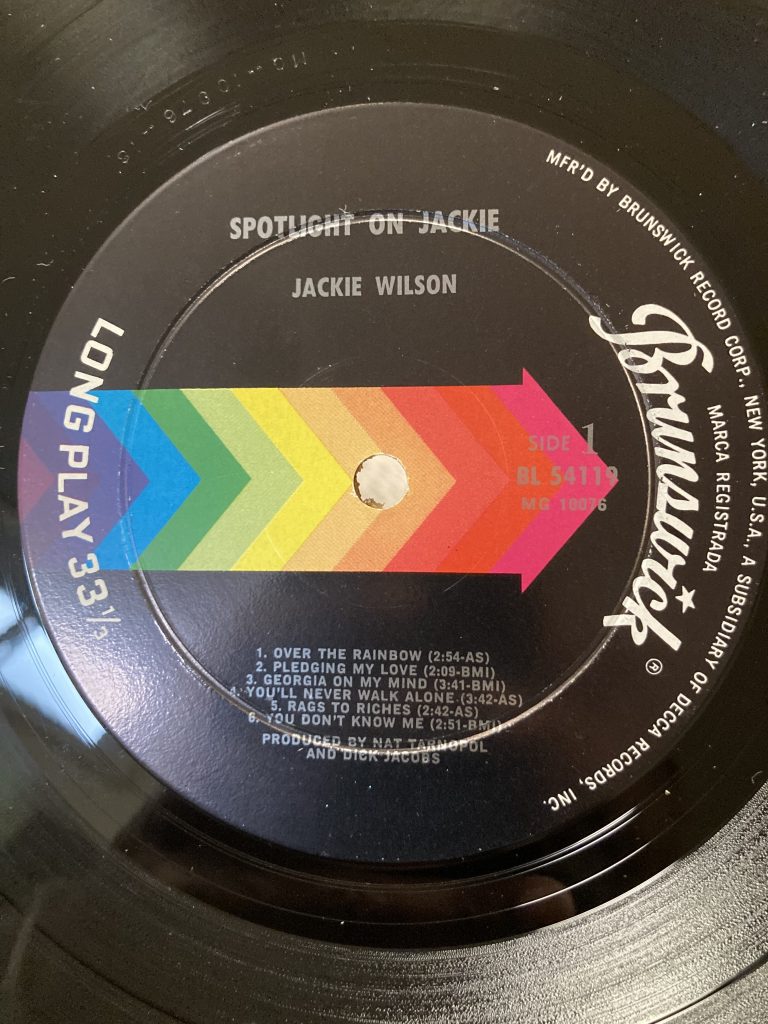
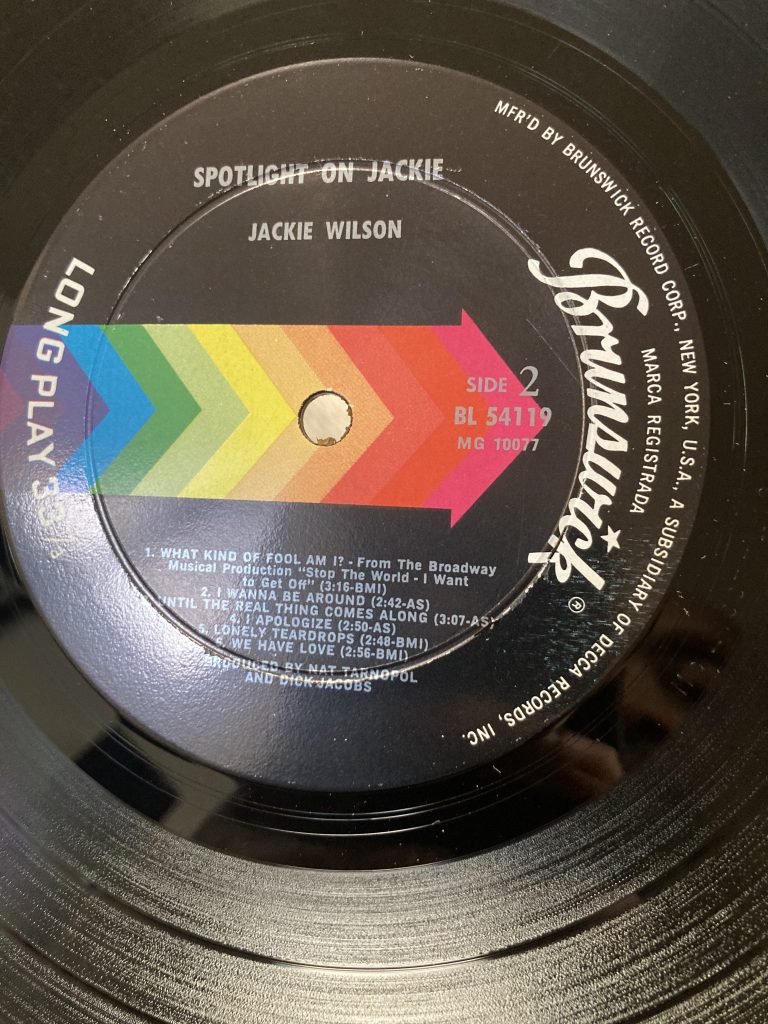
I just had to hear this!
So I snagged a vinyl copy. Clearly at some point it had been relegated to some owner's used record store bin for as little value as a buck-fifty.
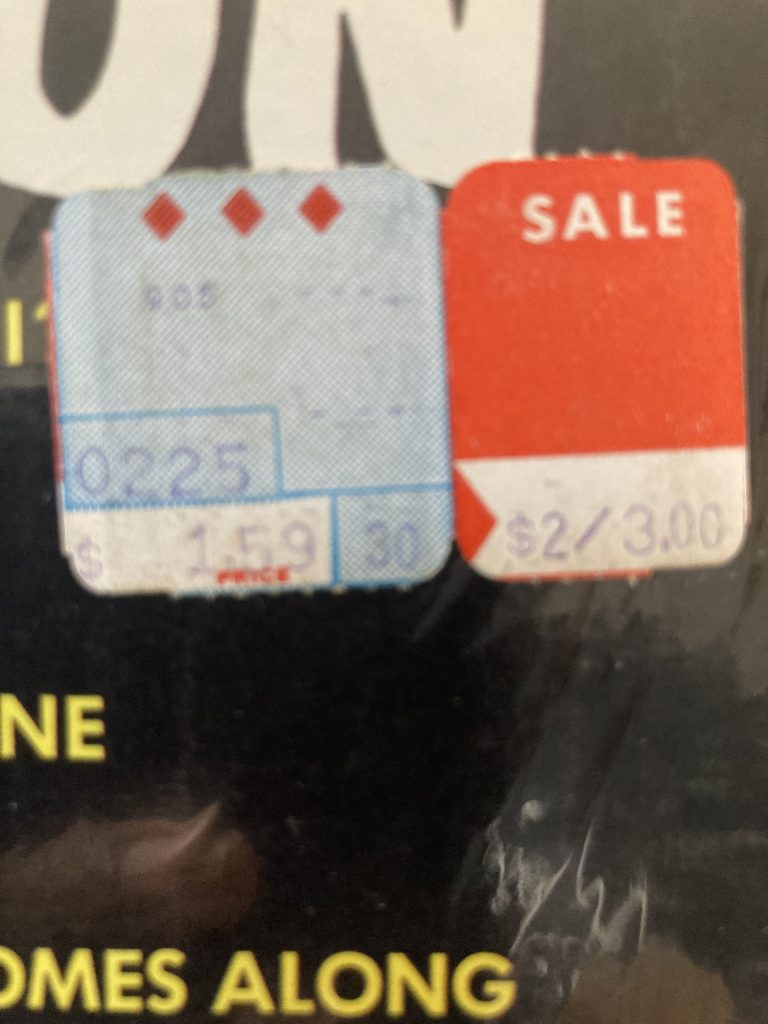
Released in mono in 1965 album, the LP has six songs on each side, packed with classics like "Georgia On My Mind," "Over the Rainbow," and a re-make of Jackie's own famous 1958 hit, "Lonely Teardrops." But this is where the real fun starts: let's really investigate the connection between the three titans. Here, then, are three different versions of the same great tune, for your scrutinous pleasure. Let the games begin!
V: Walking Alone: Together!
Roy Hamilton Rendition
Let's first examine Roy's version of the tune—the one that started it all.
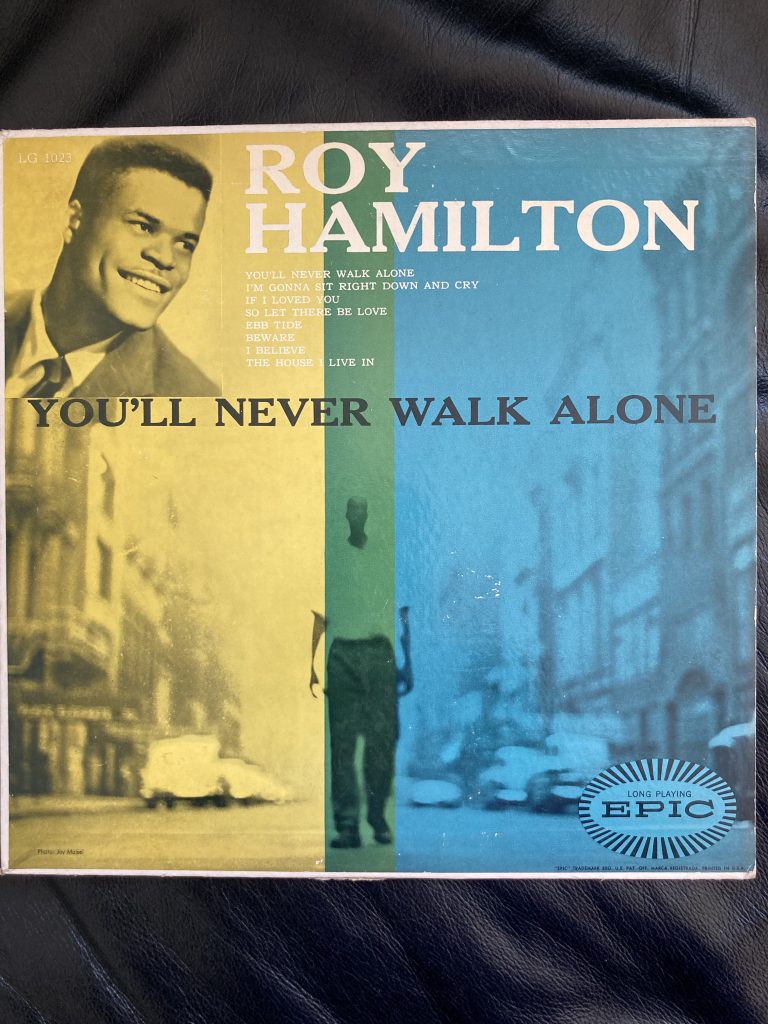
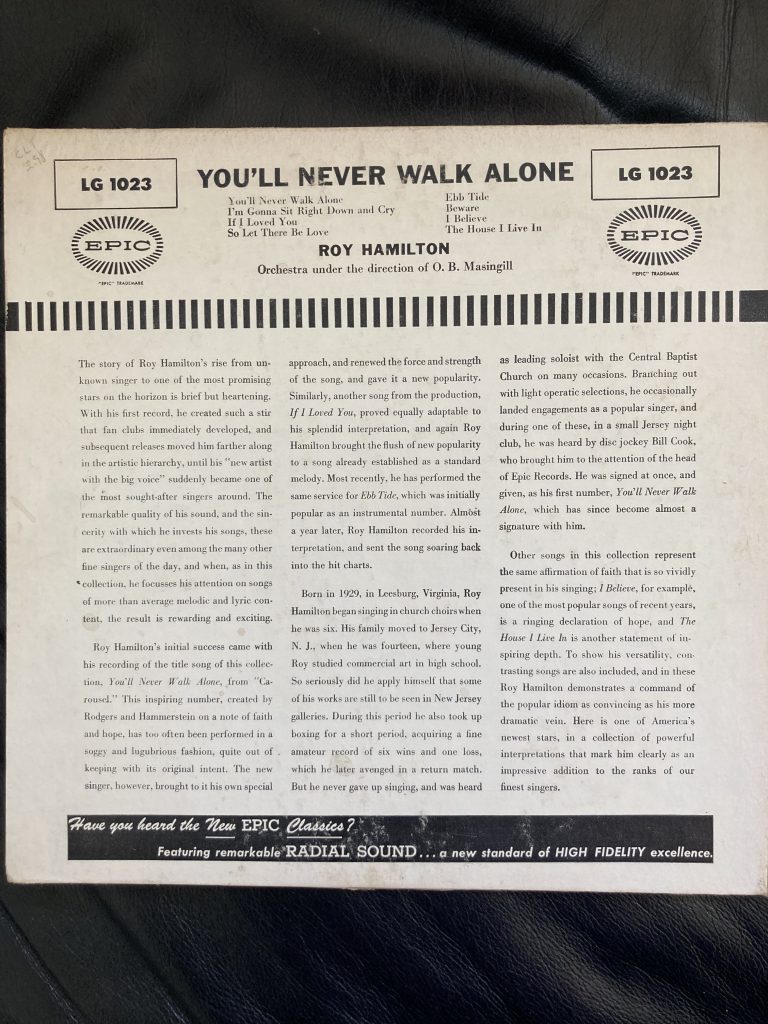
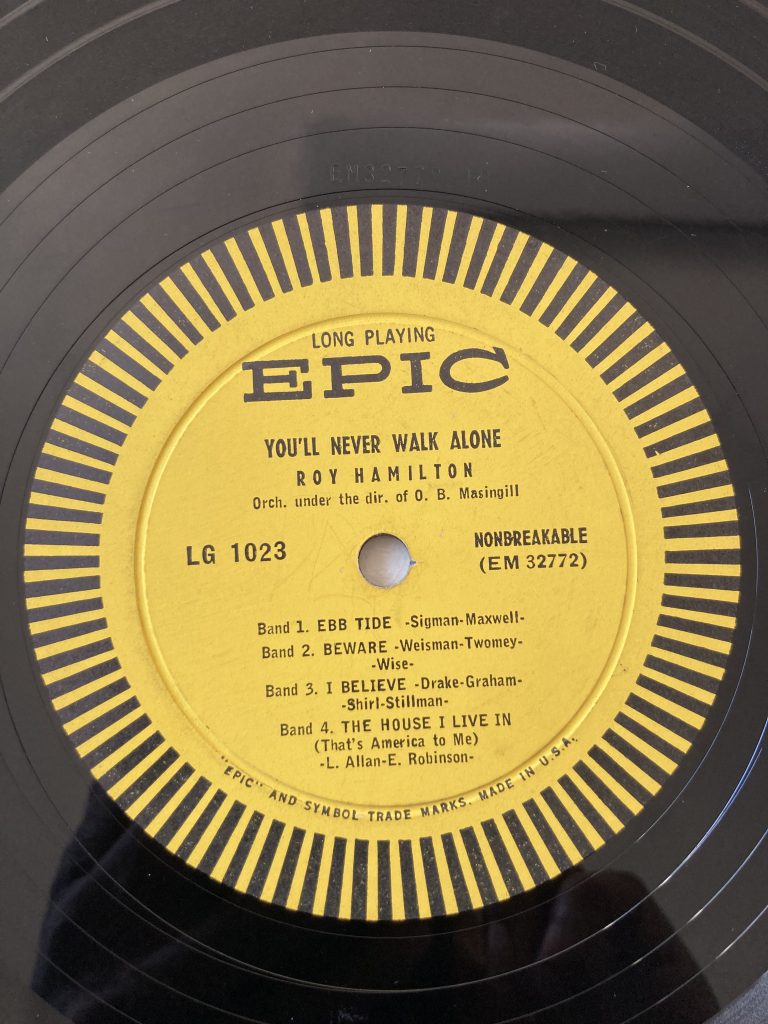
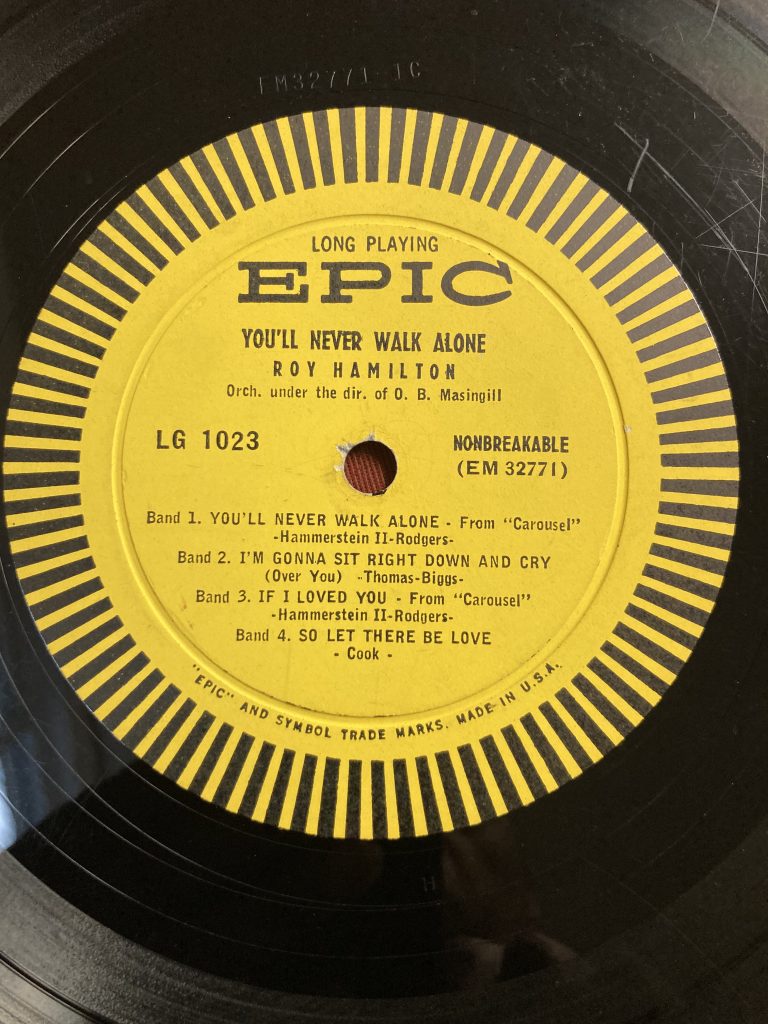
Roy's 1954 rendition is sung in key of Db (D flat)… He has a full orchestra to accompany the rhythm section. The arrangement is soft and smooth. His voice is his voice is dark, round, smooth – smoky, even. He takes his time, eventually rising to a crescendo toward the last phrase. Roy's version is majestic in its presentation. It sets the tone and benchmark for all other versions that follow.
Jackie Wilson Rendition
Then there's Jackie's version, on the "Spotlight" album recorded in mono on Brunswick label in 1965 (the recording quality sounds fantastic.) Wilson, as one might expect, had the benefit of closely studying and scrutinizing every phrase of Hamilton's '54 version. This, of course, gives him a distinct advantage, as he has a fresh template from which to work, and can expand various vocal or instrumental elements of the tune in whatever way fits what he does best. And this is exactly what Wilson did.
Though Hamilton employed a slow, majestic approach, Jackie has more natural power and projection in upper vocal registers—his voice is like a laser beam. The way he says the word "sky" comes across like "sky-high;" the word "and" is more like "aa – and"; the way he enunciates the phrase, "waaalk on" is copped perfectly from Roy. When Jackie goes high up and says "you'll neeeever," he holds it but backs off into falsetto for the remainder of the final phrase.
He sings in the key of D, a higher, brighter-sounding key than Hamilton's Db. He also has hired an extremely luscious orchestra to play behind him. Every syllable is exaggerated for effect. His backing female vocal singers—which Roy did not have—add even more to the session. The tympani, the brass section—they also create an atmosphere of regal pomp and an anticipated climax yet to come.
The way he says the phrases "hold you heeeaaaad…" "annnnddd donntt"…" is a "cooold" his voice breaks, "rainnnn" the vibrato on the word "dreams" "waaa-aaalk on.." with the Ho – ppe" the hard 'h' at the beginning and the hard ' at the end, with heavy vibrato with the "o' syllable is being held. The last time around, Jackie goes full throttle and full throated in a way that ONLY Jackie can—not Elvis or Roy could do it this way…and "neeee-vveerr wallllk." When he goes up high on the word "never," he then shifts into a falsetto. It's a stunning exhibition.
Elvis Rendition
In 1971, Camden Records (the budget-label version of RCA) released an Elvis album called You'll Never Walk Alone (CDM 1088). Here is the original mono version:
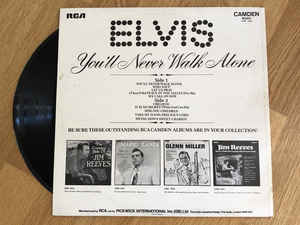
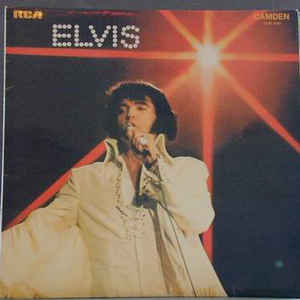

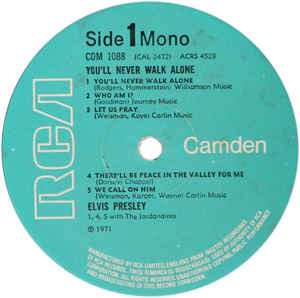
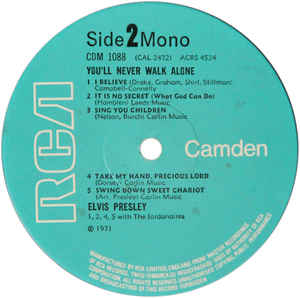
Pickwick garnered licensing rights to this album and re-issued their own version, complete with RCA's original artwork. The March 22, 1971 version of "You'll Never Walk Alone," is the one I grabbed on Discogs.
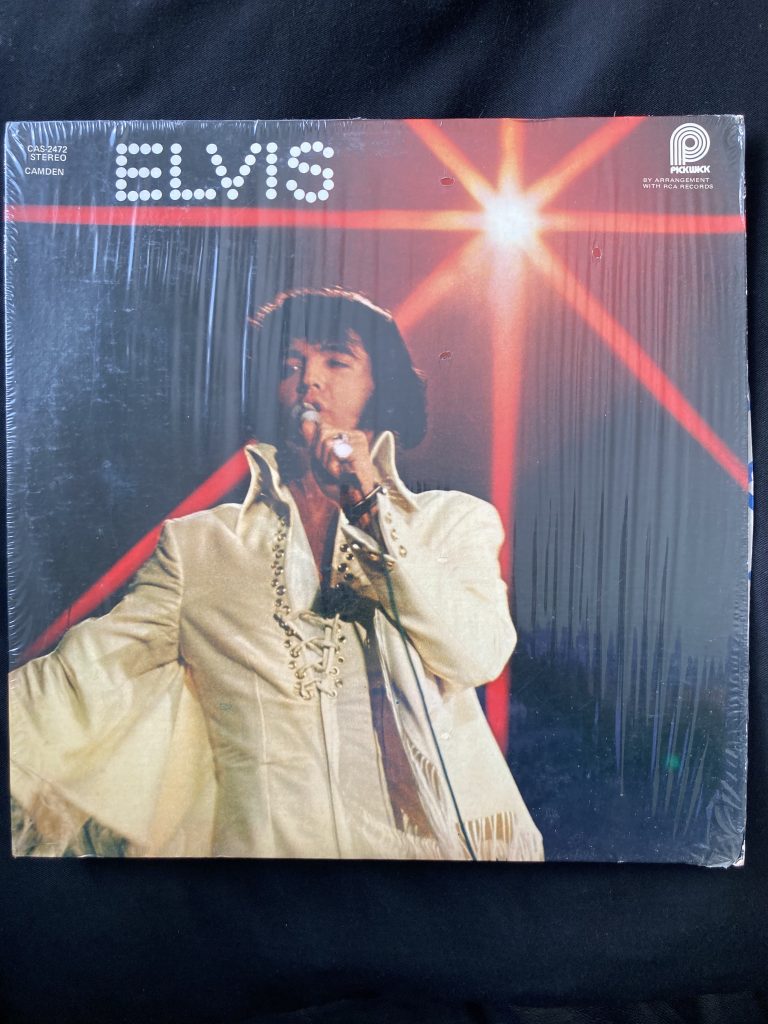
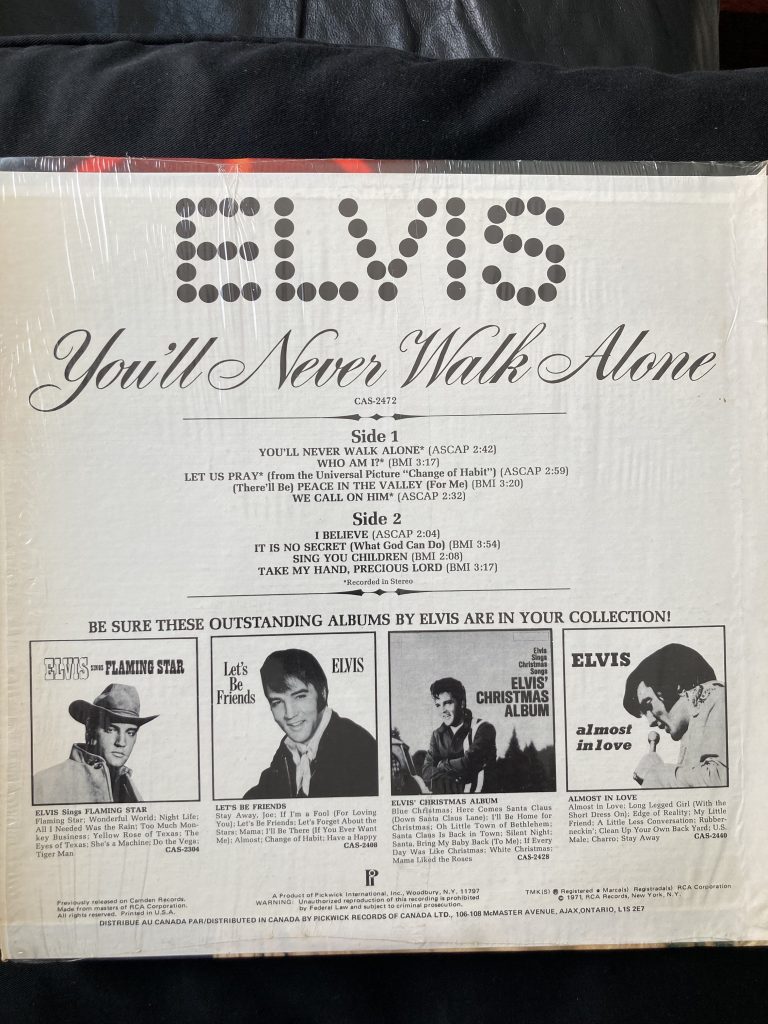
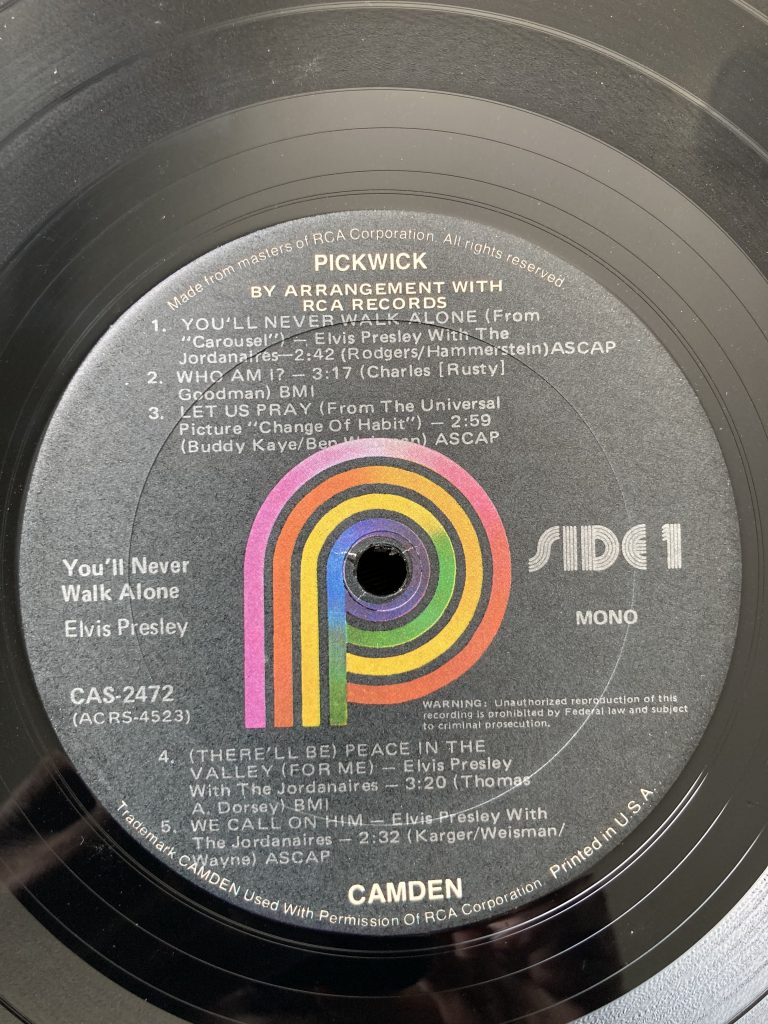
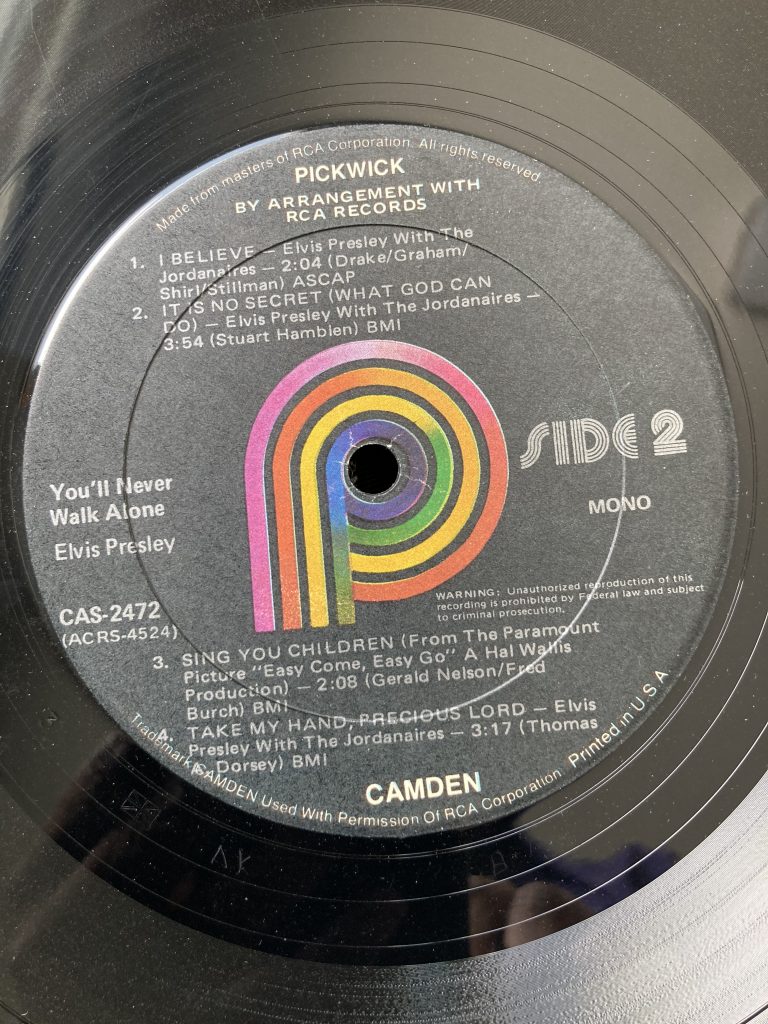
In an interesting twist, even though the LP cover says "stereo," notice the LP itself clearly says it's a mono pressing. Etched in the runout is the British flag seal, along with "CAS-2472-A-1" penned in the vinyl.
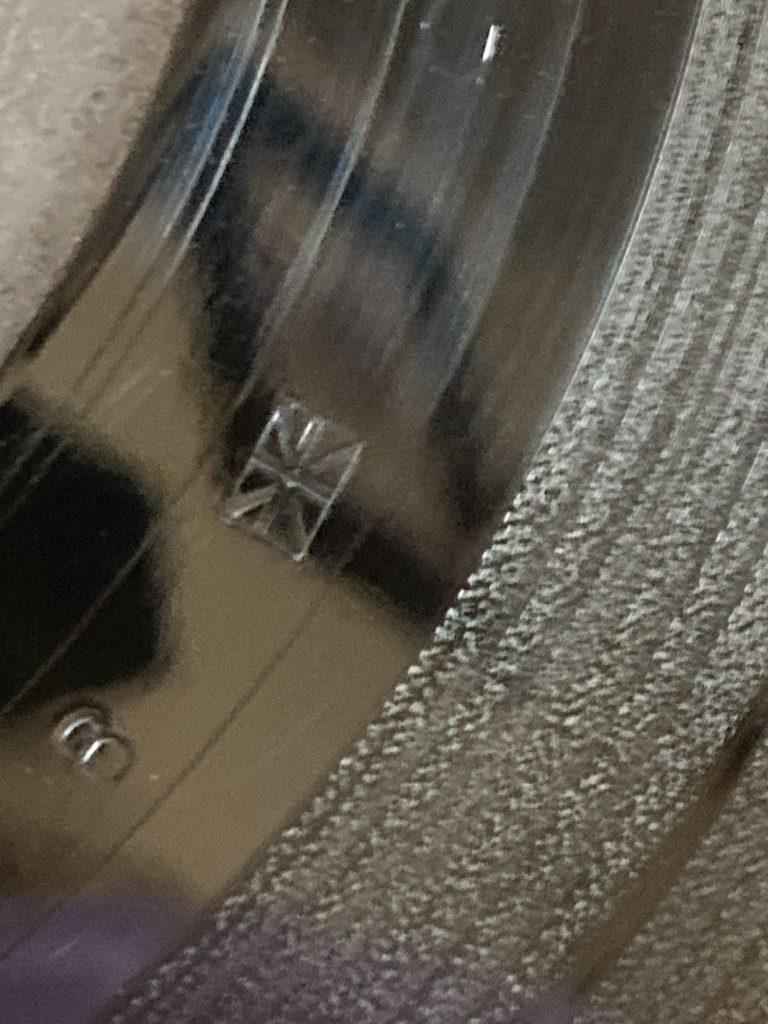
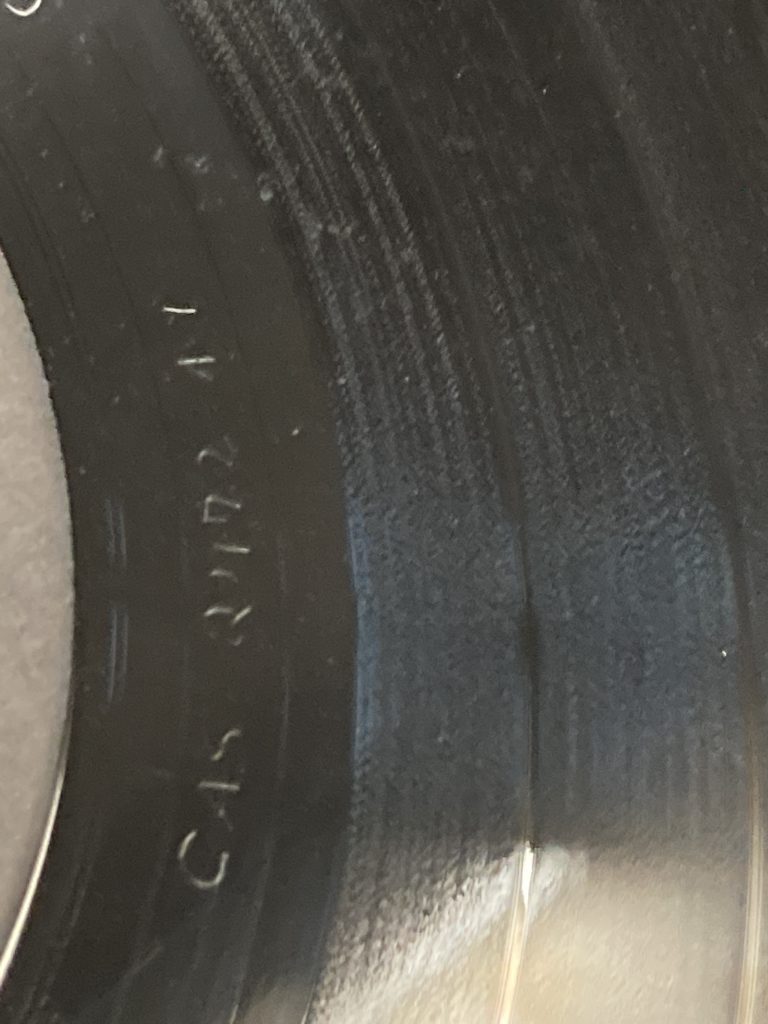
Now for the session details:
Elvis recorded his version of "You'll Never Walk Alone" on September 11, 1967. With his longtime backing group, the Jordanaires—along with the Imperials (led by Jake Hess), as well as Millie Kirkham and a couple of other extras, bringing the vocal ensemble to eleven members to create the choir effect he wanted for his gospel session. Elvis obviously had heard Jackie Wilson's version and wanted to replicate the choir effect.
Elvis sings his version in the key of C, in the lowest range among the three of them. He is also playing piano, and does a decent job accompanying his own voice, though his tempo fluctuates. The song starts at a medium-pace, with soft arpeggios played by Chip Young's nylon-string guitar. Elvis' piano is softly creeping behind in quarter notes, and Bobby Moore's bass slowly thumping in time. Presley's light chords and tempo starts to quicken a bit as he sings, and he slowly increases speed and intensity as they approach the bridge and the chorus.
They create a galloping 4/4 time feel using triplets for every beat. Presley's piano pounds rhythm, as the combined Jordanaires/Imperials choir begins to soar. The chorus begins gallantly, Elvis' piano tempo increases the rhythm, playing in twelve beats per measure, and he sings even more confidently in his classically controlled style. When he sing "you'll neeee-veer," he pronounces it "naa—aa-yy-verr." [Elvis definitely borrowed this technique from Jackie.] They slow the tempo down as if they will end the tune, but then Elvis cranks it up again for one more full round of the chorus.
By the time the song concludes, they are cruising, the Jordanaires/Imperials providing wings underneath Elvis whose voices is flying high during the last verse before he makes a smooth landing in the low register of the last vocal phrase, "you'll never walk aloh-ho-ho-ohne." Then he does it yet again, even more vigorously this third time around. He ends with a slow, soft, piano flourish, and you can actually hear him let out a last breath of exhaustion.
Elvis recorded a gospel album for RCA Victor recorded a gospel in Nashville between 25th and 28th of May, 1966. How Great Thou Art (LSP-3758) was released to great acclaim.
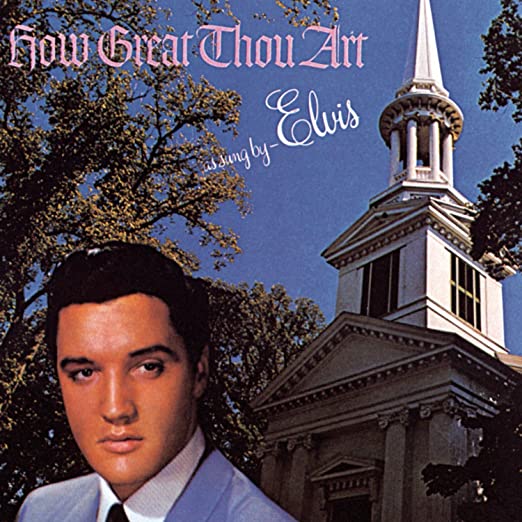
After Presley's death, it was reissued in CD format, first in 1987, and again in 2006. The latter version contains the original sequence of ten tunes plus three bonus tracks—one of which was "You'll Never Walk Alone."
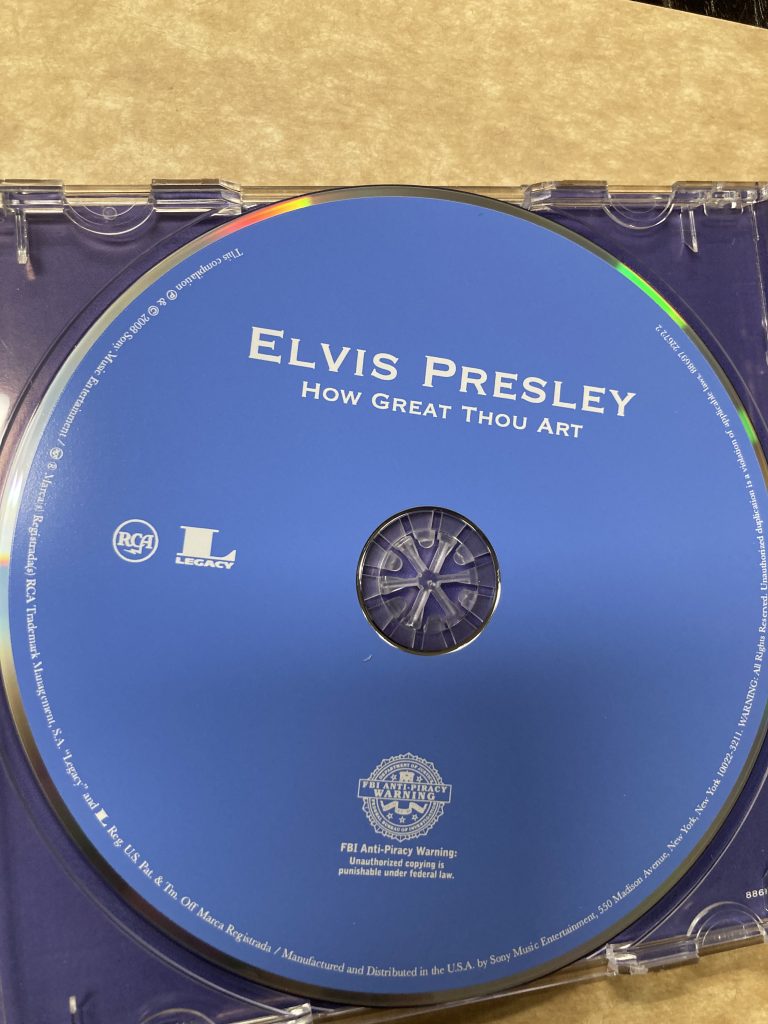
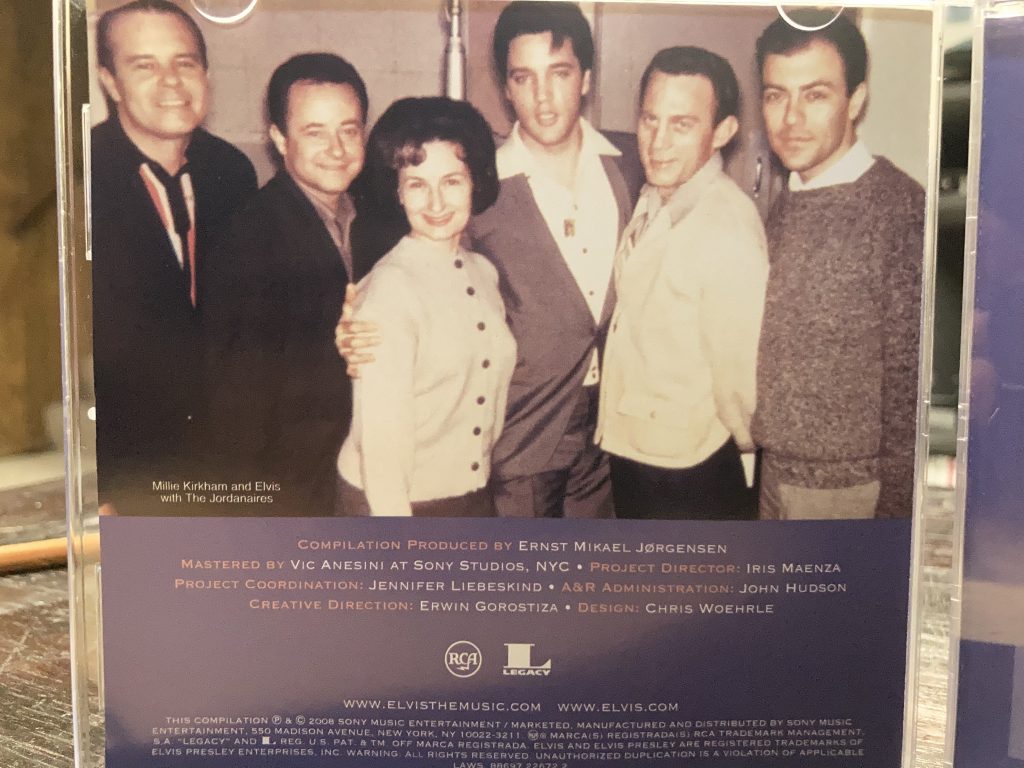
I was trying to see the connection between Hamilton and Elvis: I was trying to see the connection between Hamilton and Presley: I was trying to see the connection between Presley and Wilson: I was trying to see the connection between Wilson and Hamilton!
It's true, hindsight is 20-20. And suddenly my moment had occurred: Had I known more about it back then, I would have been able to perceive that both those men—Wilson and Presley—borrowed more from Roy Hamilton even earlier than they'd gotten from each other. After all, Roy came first and was THE originator of that particular brand of crooning. But Jackie took the ball and ran with it, having much more sex appeal, stage presence, soul, sweat, and swagger than Roy's polished performance ever generated. Yes, Jackie took it to another level. And finally, we all know what "The King" did – he borrowed the best of both men, and turned it into a brand, a franchise, a marketing bonanza, that we will never see the likes of again.
In Peter Guaralnick's epic two-part bio, Last Train to Memphis (Vol.1) he mentions Presley studying and imitating Roy's style as early as 1955, when Elvis sang, "I'm Gonna Sit Right Down and Cry," doing his best imitation of Hamilton. In Careless Love (Vol. 2) he mentions how Elvis first saw Jackie Wilson's Las Vegas performance in 1956, and again when they met in 1966 backstage at the Trip Nightclub on Sunset in L.A., when Jackie literally taught Elvis the tricks regarding how to sweat to make the women go wild. And there are two pages devoted to the studio session that Chips Moman arranged that allowed Presley and Roy Hamilton to meet and bond in North Memphis for that epic recording session in January at American Sound Studios—the final recording session of Roy's life, and also the one that revitalized Elvis' career. The album, From Elvis in Memphis, was his swan song.
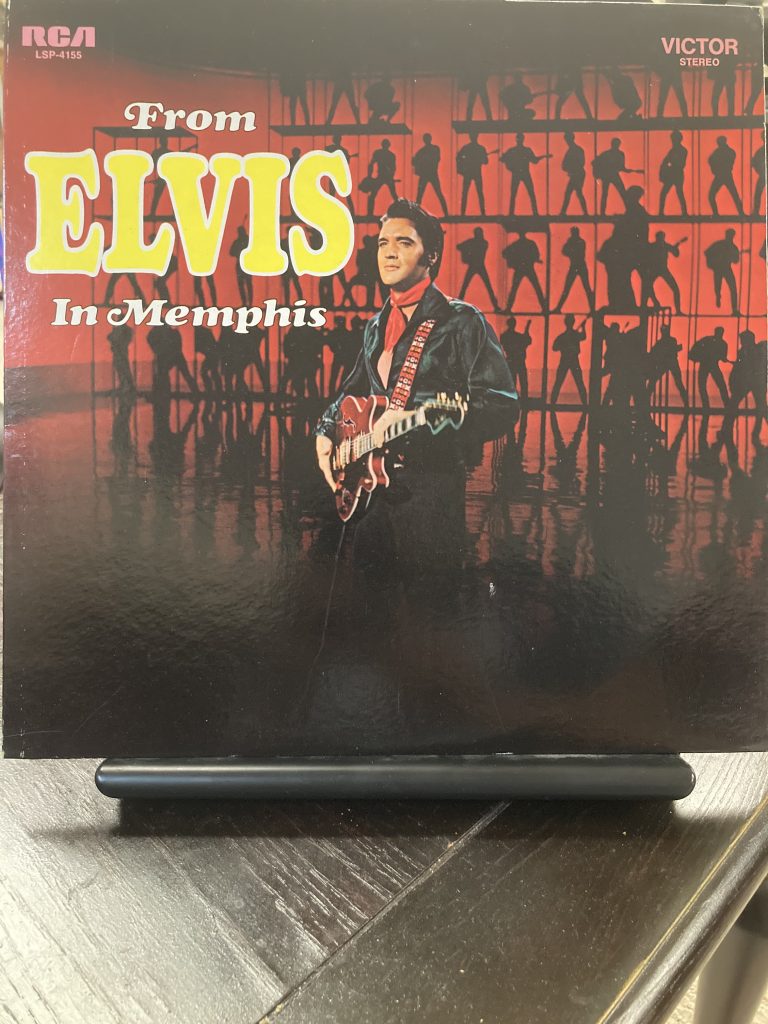
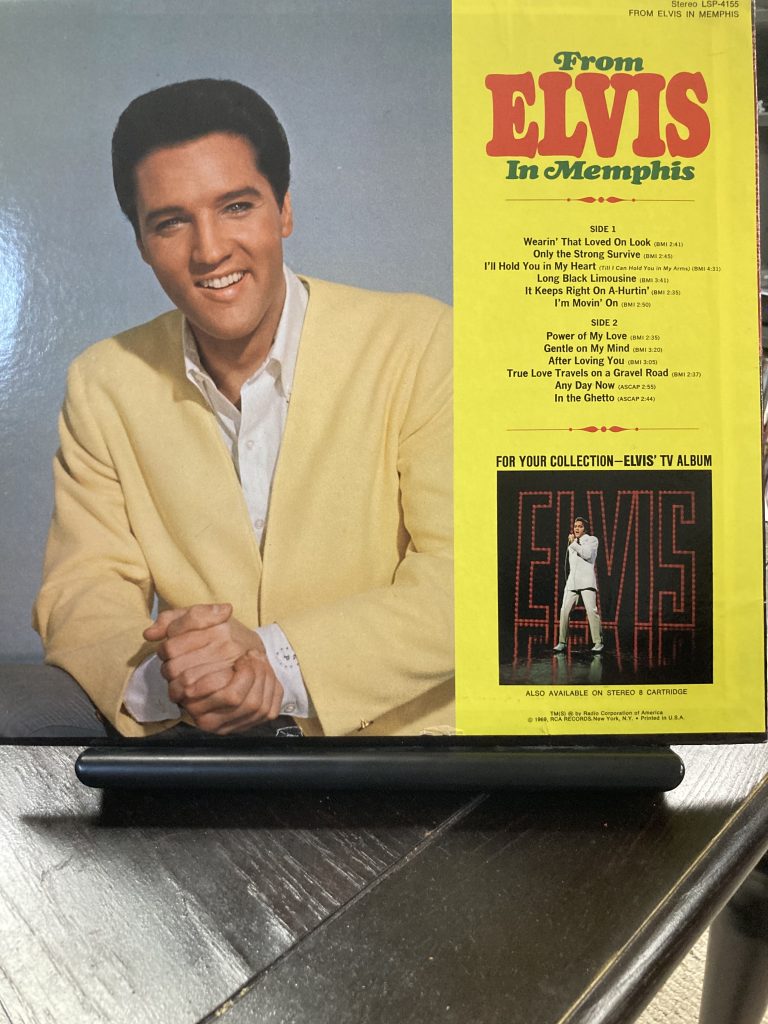
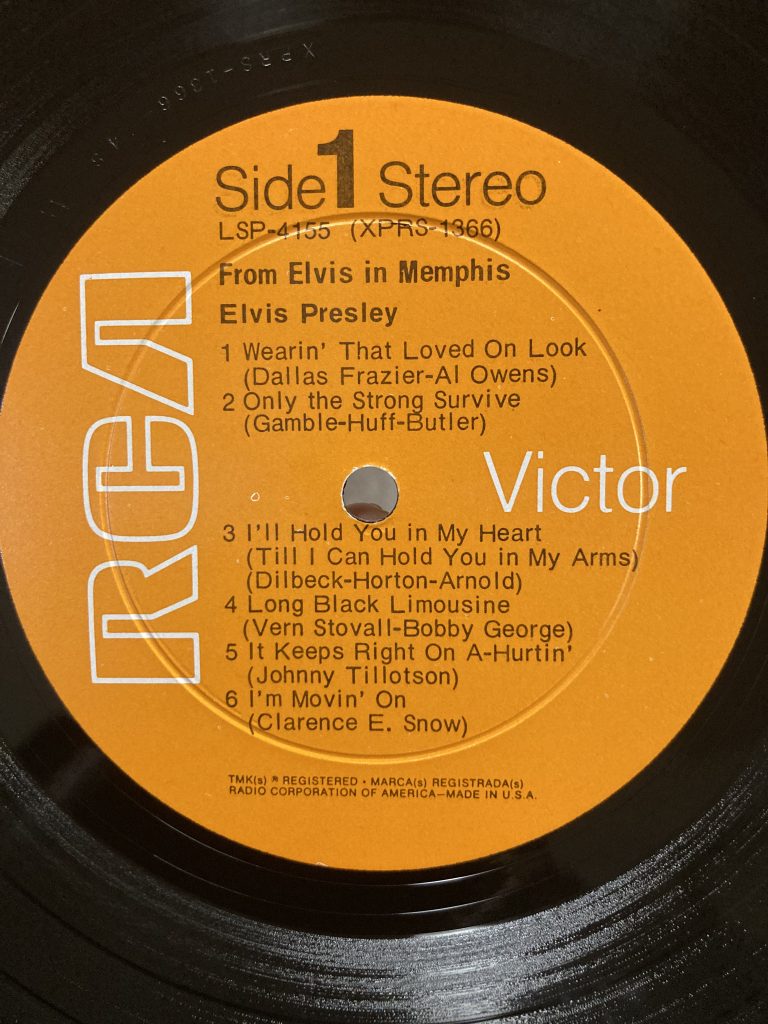
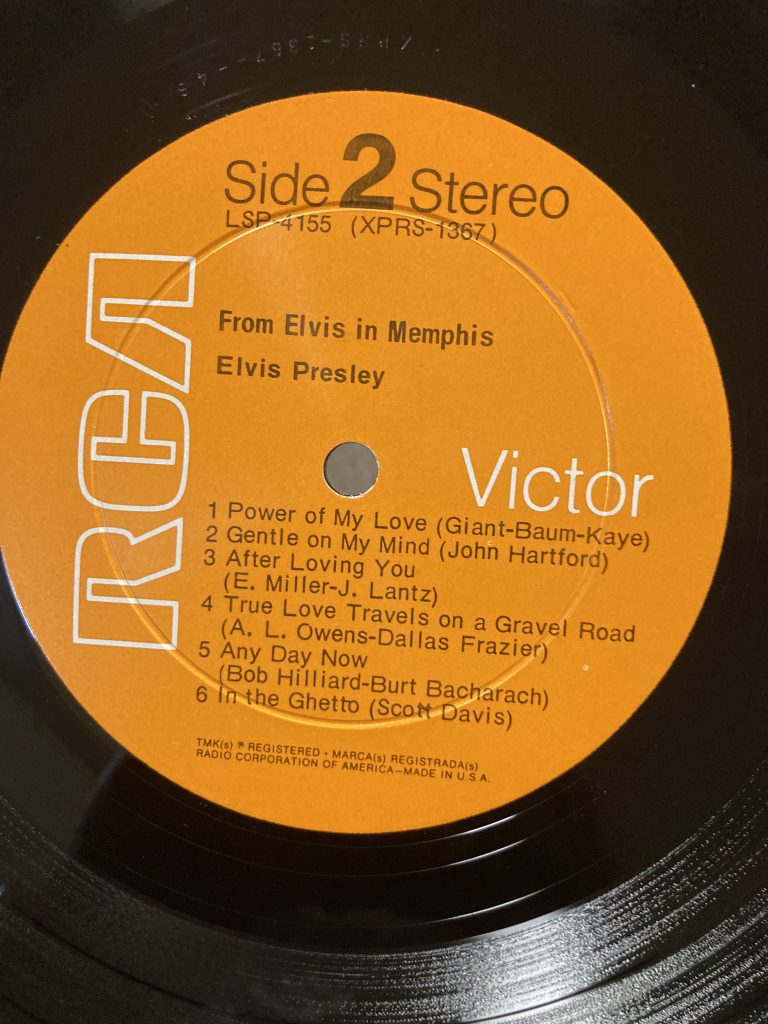
This last, great session yielded two of the last greatest hits Elvis recorded—"Suspicious Minds," and "In the Ghetto"—gave him his first top ten hit and gold record since 1965.
In the end, Elvis—all along—had been carrying the soul of black folks. Or maybe they had been carrying him. Whichever way it was, to his credit, it was something that he never denied. Roy Hamilton, Jess Stone, Otis Blackwell, and Jackie Wilson had been with him all along. It is, then, fair to say that the Elvis we knew would not be the Elvis that he was without Jackie Wilson, and, maybe even more importantly, without Roy Hamilton, who got the ball rolling, and was Elvis' real friend all the way 'til the end.
And that is my black history contribution to Positive Feedback for 2021.
Wayne Goins' audio system for this article:
As usual, the workload is generally divided up between my two rigs which are individually set up for mono recordings and stereo recordings. The mono setup was on my Technics SL 1200 MK2 turntable, with the Hana MSL mono cartridge mounted on the tonearm. I have the Technics running through Channel 5 the Rega Rega Brio integrated amplifier, with the Rega Apollo CD player ready whenever I need it (which I did, with the Elvis disc).

The vinyl was powered by my trusty Modwright combo of the PH 9.0 and the MWPS power supply that drives it. As always, I used Audioquest (King Cobra Red, Diamondback Blue, and Goldengate Red) audio interconnects. All my Rega components sit on my sturdy Pangea rack.
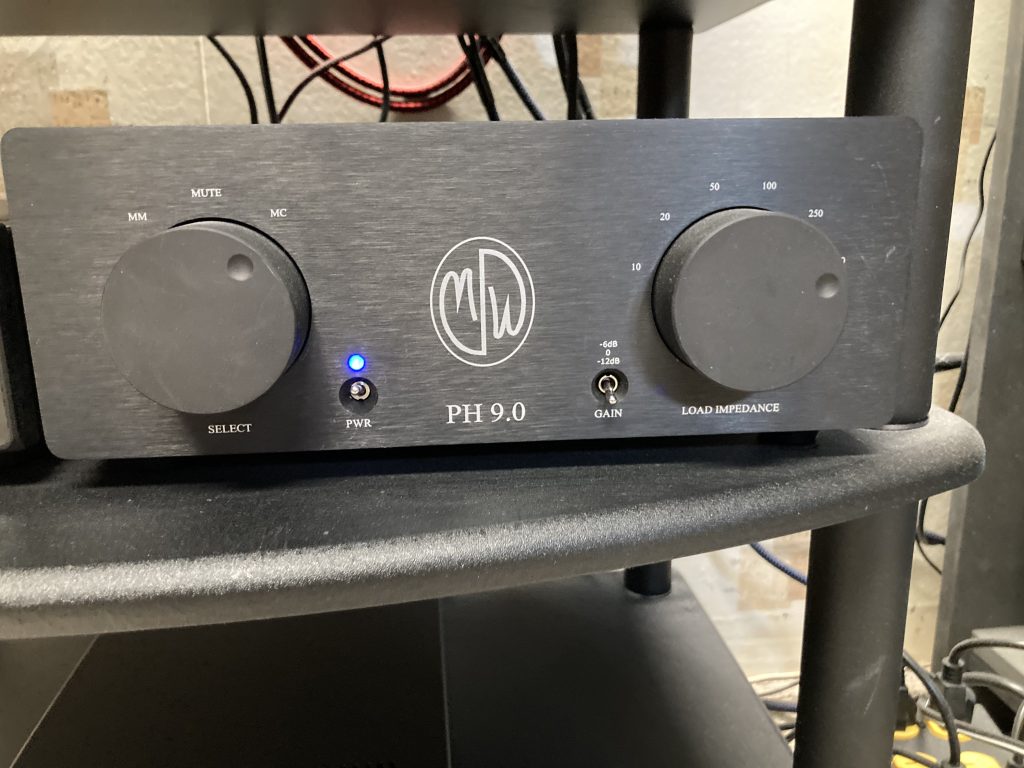
Next to it sits the stereo rig, which includes my trusty Rega Planar 6 with a mounted Hana ML stereo cartridge and the accompanying speed 33/45 rpm speed controller.
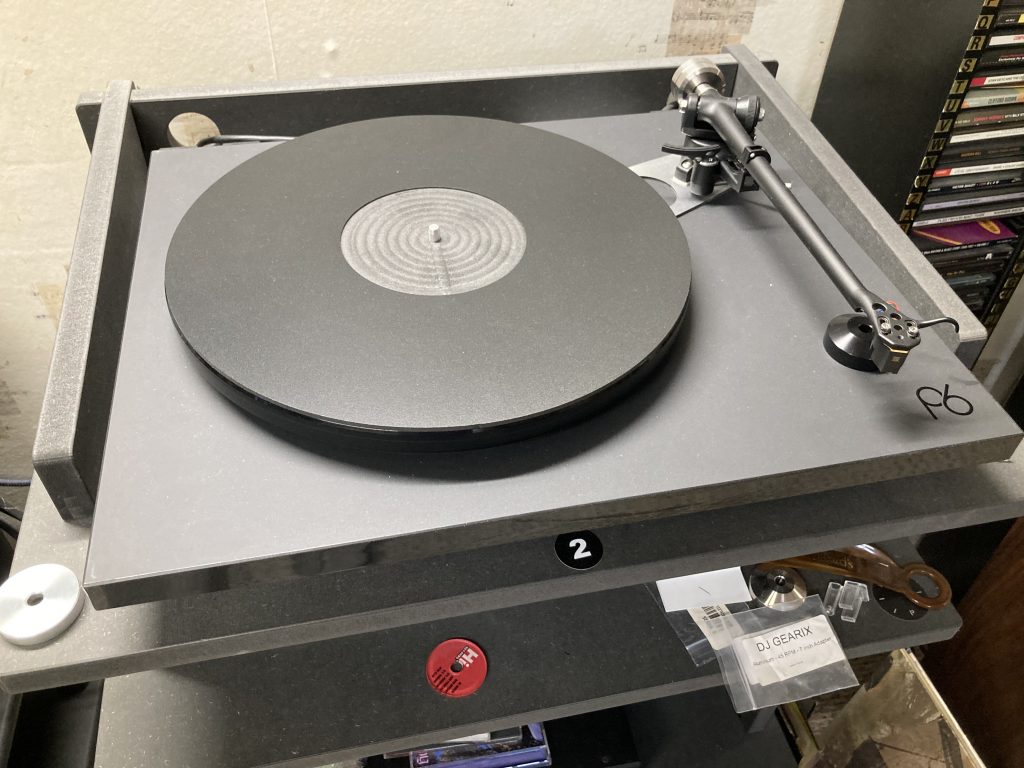
This is tastily paired with the Musical Surroundings NOVA III receiver, powered by the accompanying LCPS power supply. To close the deal, both rigs are driven through the my splendid Spendor A5 model speakers.
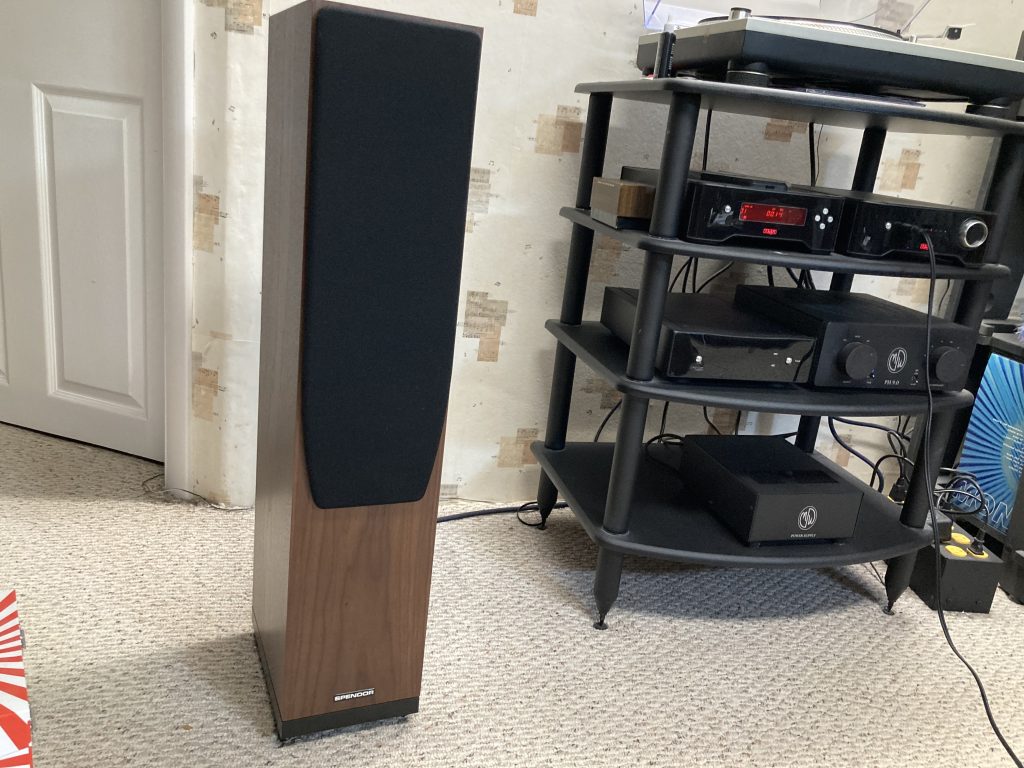
I use an Achromat turntable mat for my platters to enjoy an extra-smooth ride. With regard to interconnects, I used Grover ZX+ cables to go from the Nova III to the turntable, while keeping continuity with the same brand of interconnects I used on the other rig: a pair of 2m length Audioquest Diamondback Blue and King Cobra Red RCA cables. All this equipment sits safely on a Line Phono turntable stand.




